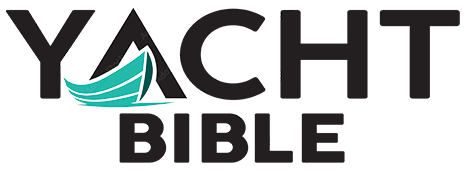

SuRi Yacht – The Amazing $45M – Superyacht
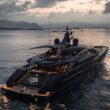
The Best Yacht Concepts From Around The World
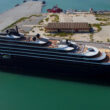
The Stunning Ritz Carlton EVRIMA Yacht
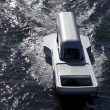
Gliding Across Tokyo’s Sumida River: The Mesmerizing Zipper Boat
- Zuretti Interior Design
- Zuretti Interior
- Zuccon International Project
- Ziyad al Manaseer
- Zaniz Interiors. Kutayba Alghanim
- Yuriy Kosiuk
- Yuri Milner
- Yersin Yacht
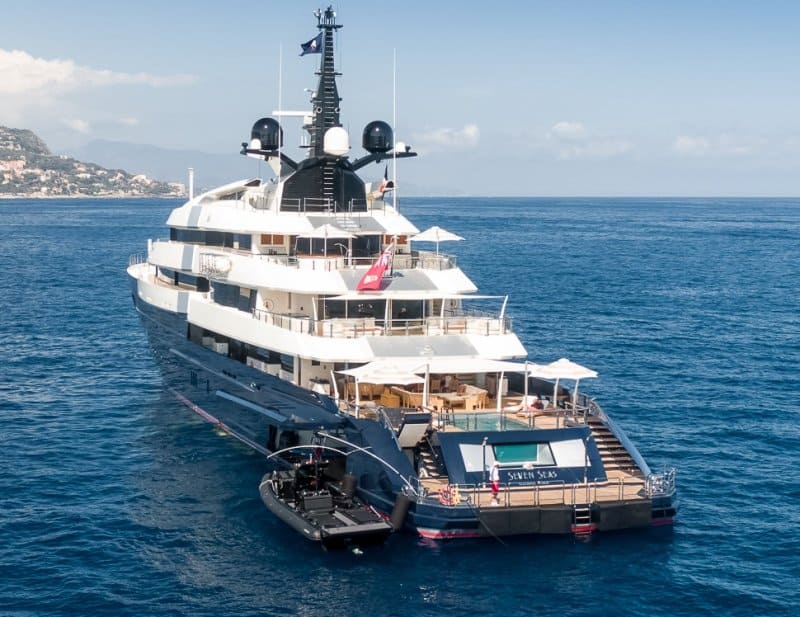
- Superyachts
MAN OF STEEL Yacht – Premier $150 M Superyacht
Measuring 86 meters, she is one of the world’s largest yachts.
Previously known as SEVEN SEAS, the name was inspired by the fact Spielberg had seven children. He owned the vessel from her delivery in 2010 through to 2021.
| Man of Steel | |
| 86m | |
| 14 | |
| 26 | |
| Oceanco | |
| Nuvolari Lenard | |
| Nuvolari Lenard | |
| 2010 | |
| 20 knots | |
| MTU | |
| 2,658 ton | |
| 1010777 | |
| US $150 million | |
| US $10–15 million |
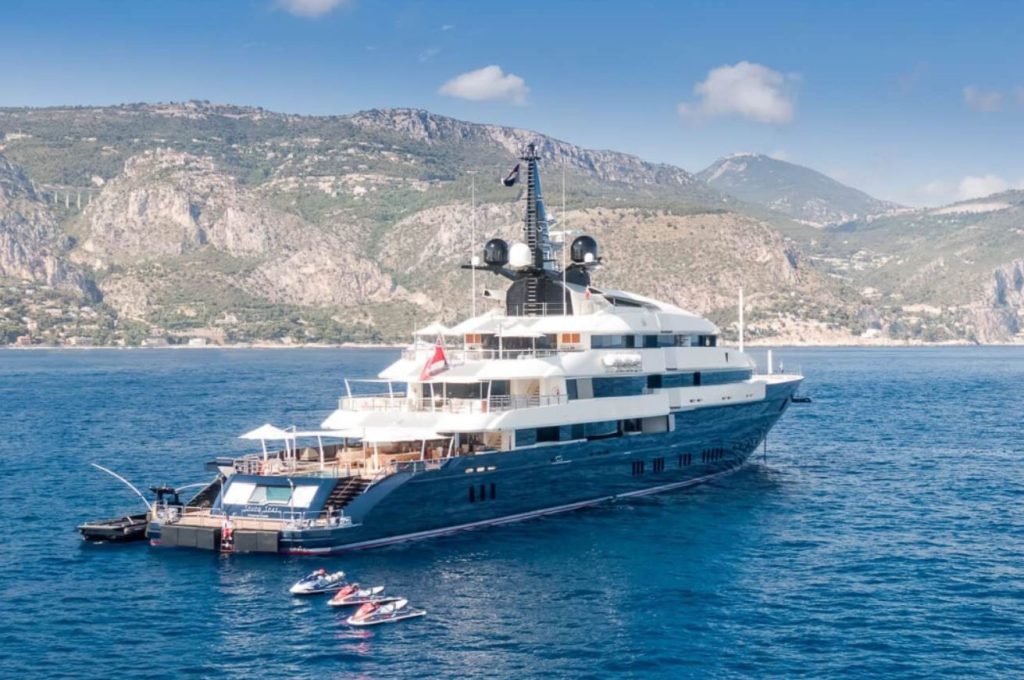
MAN OF STEEL yacht interior
The interior of the MAN OF STEEL yacht includes a fully equipped gym, a spa, a beach club, a movie theatre, a beauty salon, a dance floor, and of course, a glass elevator that connects the different levels of the yacht.
The gym is arguably one of the most impressive parts of this superyacht as it has floor-to-ceiling windows providing great views from one of the upper decks of the vessel.
This allows guests to have a beautiful view of not only the pool below but also the breathtaking scenery this yacht might pass when underway.
The private owners’ deck offers a fantastic state-of-the-art master bedroom with its own dressing room as well as an attached office or study. This suite includes its own private deck area with a sizable jacuzzi perfect for relaxing and drinking a glass of wine under starry skies.
The six additional luxurious suites can accommodate 12 additional guests allowing the MAN OF STEEL to welcome up to 14 guests in total who are tended to by 23 crew members. The MAN OF STEEL interior was designed by Nuvolari & Lenard and Molly Isaksen and is equipped with exquisite furniture made of walnut, teak, and rosewood, accented with natural materials and fabrics.
The design of the yacht interior is simple yet classy, with clean and minimalist spaces. Wooden furnishings can be found in all parts of the vessel, although the interior is not as opulently furnished and decorated as other superyachts in its price category.
Nuvolari & Lenard is a renowned design duo that specializes in traditional yacht design for vessels between 25 and 185 meters in length. Their aim is to redefine beauty while keeping classical elements in mind.
In collaboration with the American interior designer Molly Isaksen, they created a one-of-a-kind fusion of naval architecture, incorporating contemporary and traditional elements in the interior of this beautiful vessel. The MAN OF STEEL offers a 250 square feet semi-covered sundeck, which is located adjacent to the main salon that provides enough space for larger events and celebrations aboard the vessel. A crew of 23 members of staff offers an excellent 5-star service and fulfills every possible wish of the guests onboard the MAN OF STEEL superyacht.
With excellent fine dining capabilities and luxurious amenities, this yacht is ideal for private ownership as well as high-end charter service.
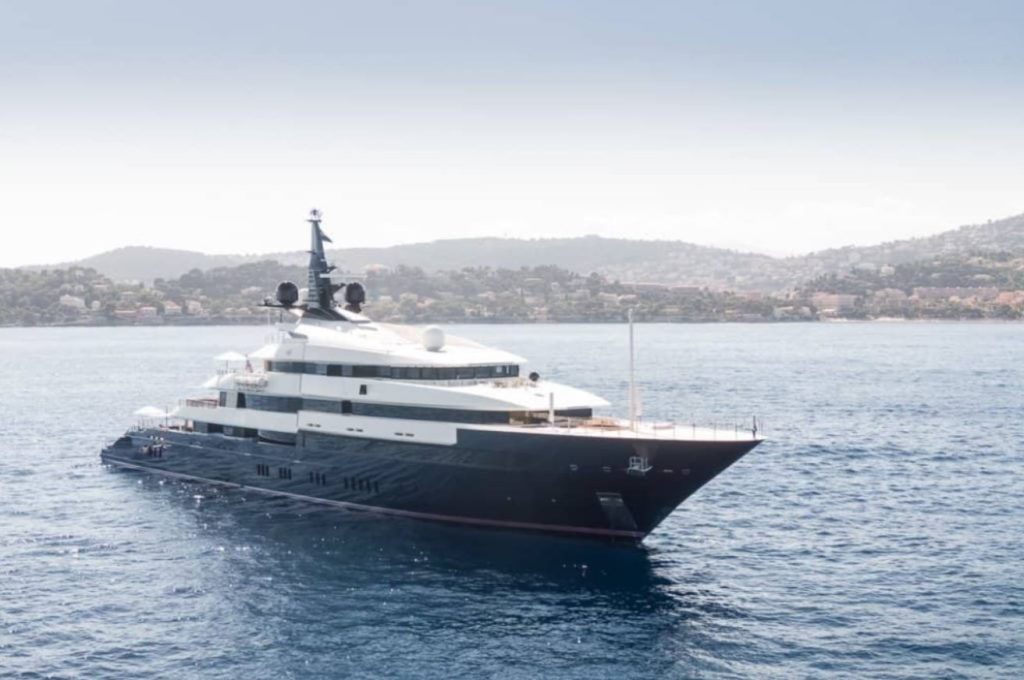
Yacht specifications
The MAN OF STEEL has a length of 86 meters (282.15 ft) with a beam of 14.2 meters (46.6 ft) and a draft of 3.91 meters (13 ft).
She was built by Oceana in Alblasserdam, the Netherlands using mainly steel and aluminum which is their specialty. MAN OF STEEL was completed and delivered to Steven Spielberg in 2010. The yacht has her main port in George Town, the capital of the Cayman Islands, under whose flag she sails and she has been spotted as far south as the port of Puerto Escondido . With a weight of 2.658 tons and an output of 6,984 kW (9,496 hp), the MAN OF STEEL can reach top speeds of 20 knots.
Her maximum range lies at 4,750 nautical miles, which is respectable considering her size.
Yacht exterior
Designed by Azure Naval Architects and styled by Nuvolari & Lenard, the MAN OF STEEL yacht combines exceptional craftsmanship with unique outlines. The hull of the ship is set in an elegant dark blue, while the upper decks were left in the traditional brilliant white that many yachts bear. On the aft deck, you will find an impressive infinity pool with an incredible 4.6 meter (15 ft) glass wall, which doubles as a movie screen if required. The aft has another slightly smaller pool as well as a sizable deck with comfortable seating. This deck can be used as a helipad for smaller aircraft allowing guests to arrive in style. When this area isn’t needed for landing purposes, it can be covered completely by large awnings providing additional shade to guests.
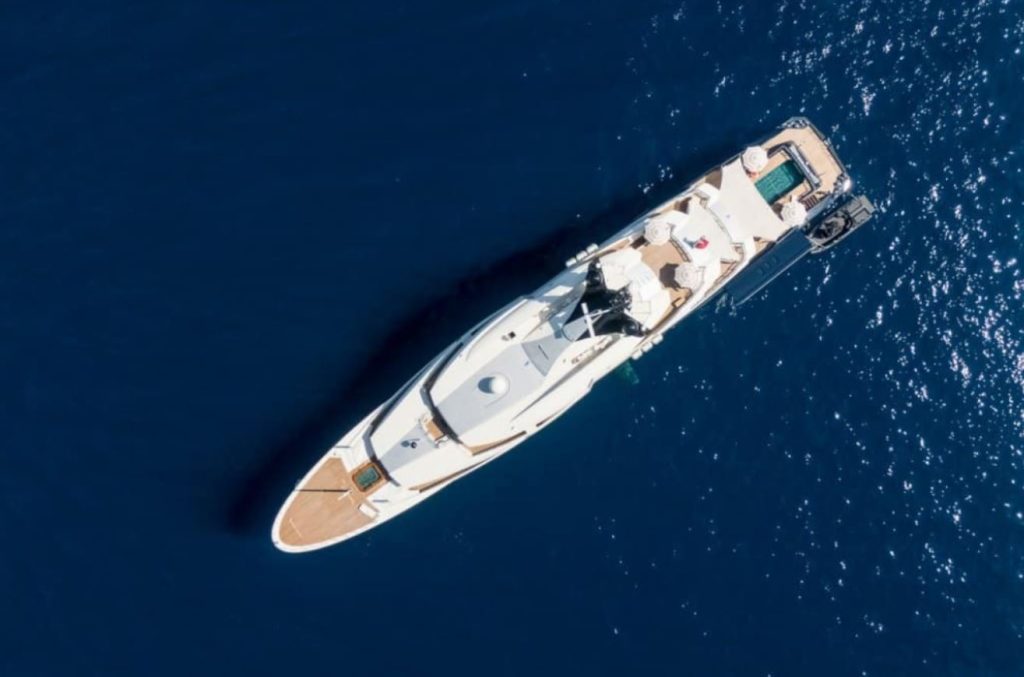
Toys and equipment
A yacht this size naturally comes with lots of toys and equipment to entertain the guests onboard.
The MAN OF STEEL carries four jet skis, several sea bobs, kayaks, paddleboards, snorkeling equipment, and much more.
The two tenders onboard the vessel are always ready to take the guests to the mainland or to the nearest secluded beach.
Spielberg purchased them from Hodgdon Yachts, a shipyard based in Maine in the United States after MAN OF STEEL was delivered in 2010.
The larger of the two tenders, the Limo, has space for twelve people with luxurious leather upholstery, flatscreen television, and air conditioning.
When the weather is nice, the roof of the tender can be lifted and opened using hydraulics.
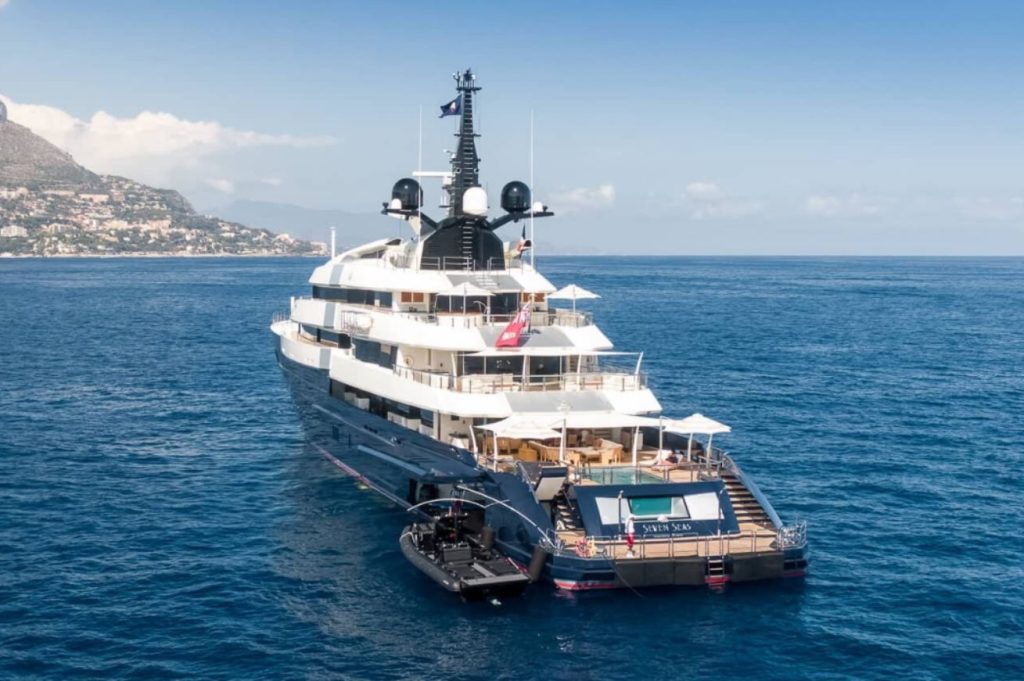
Additional information
In 2013 MAN OF STEEL was overhauled and refitted by Amico & Co, a well-known superyacht repair and design company.
The shipyard is based in Genoa, Italy, and has a 60,000 m² dock and operating area where work on both smaller and larger vessels can be carried out.
Do you have anything to add to this listing?
- Nuvolari Lenard
- Steven Spielberg
Love Yachts? Join us.
Related posts.
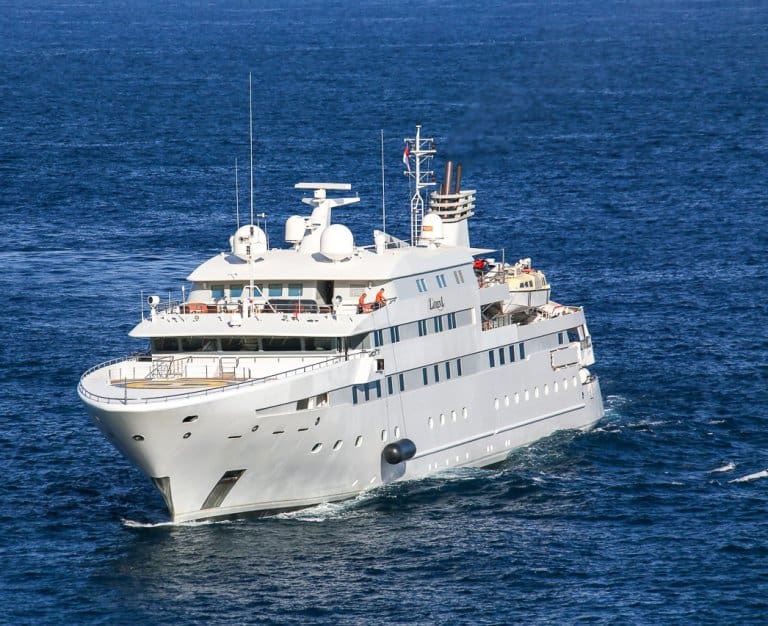
LAUREN L Yacht – Elegant $75M Superyacht
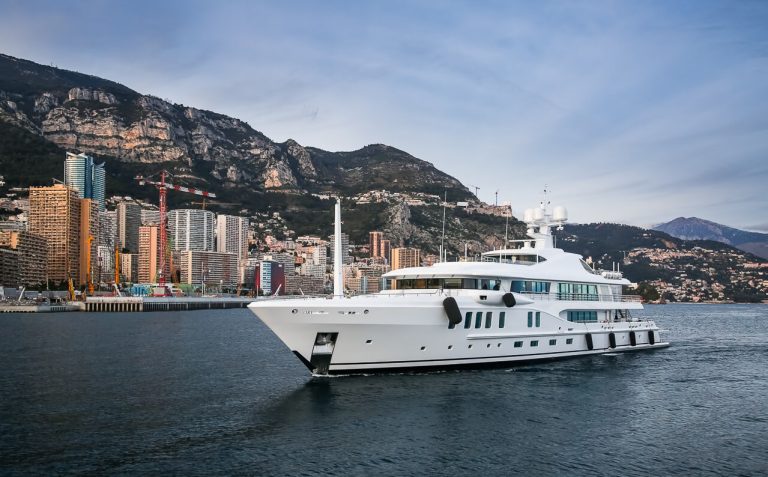
NENINKA Yacht – Epic $80 M Superyacht
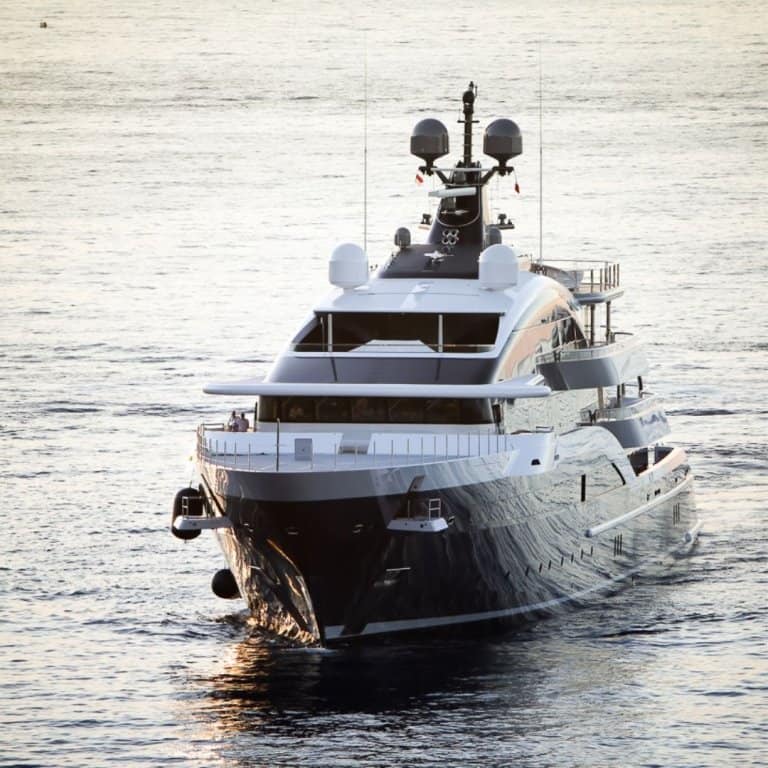
DAR Yacht – Exceptional $175M Superyacht
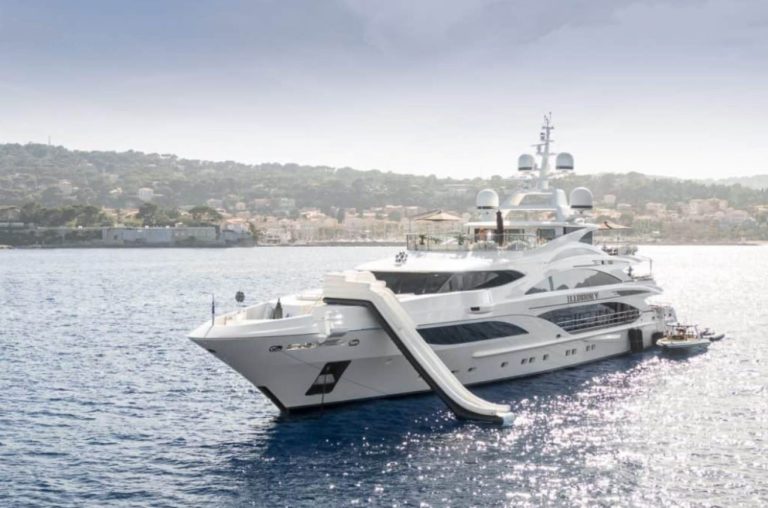
ILLUSION V Yacht – Sailing in Style $45M Superyacht
'Man of Steel' a pricey boat, but fit for a billionaire
You can save this article by registering for free here . Or sign-in if you have an account.
Article content
Editor’s note: The photo above is being used under the following commercial licence:
https://creativecommons.org/licenses/by/2.0/. The photographer is John Lambert jlambertphotos.foliohd.com .
Local steel magnate Barry Zekelman’s latest recreational acquisition may have a cost a boatload of cash, but now he can boast lots more elbow room while off cruising the world’s oceans.
Subscribe now to read the latest news in your city and across Canada.
- Unlimited online access to articles from across Canada with one account.
- Get exclusive access to the Windsor Star ePaper, an electronic replica of the print edition that you can share, download and comment on.
- Enjoy insights and behind-the-scenes analysis from our award-winning journalists.
- Support local journalists and the next generation of journalists.
- Daily puzzles including the New York Times Crossword.
Create an account or sign in to continue with your reading experience.
- Access articles from across Canada with one account.
- Share your thoughts and join the conversation in the comments.
- Enjoy additional articles per month.
- Get email updates from your favourite authors.
Sign In or Create an Account
Zekelman Industries has been identified as the buyer of movie mogul Steven Spielberg’s Seven Seas, a so-called ‘superyacht’ which went on the market earlier this year. Already renamed Man of Steel, the 2010-built luxury cruiser was listed for sale at a cool US$158 million (C$202 million).
It’s a 282-foot (86-metre) floating palace of sleek elegance. There’s a helipad, swimming pool and jacuzzi on the deck; cinema; gym and massage, sauna and steam rooms; nine cabins, including owner’s suite with private deck and a VIP stateroom. There’s room for 20 guests and crew quarters for 28 staff to serve them while afloat.
An elevator carries occupants to the various decks, adorned in teak and other exotic materials. The yacht carries two custom-built tenders — a 30-foot open sport boat and 34-foot “limousine” boat.
With an estimated top speed of 20 knots (37 km/h), it has a cruising range of 5,200 nautical miles (9,630 km) at 16 knots.
It’s the latest “Man of Steel” incarnation for the steel magnate who lives in Lakeshore and whose father Harry Zekelman founded steel tube manufacturer Atlas Tube in Harrow in 1984.
His first superyacht to carry the Man of Steel name was a 121-foot (37-metre) Heesen 3700 purchased in 2005. That was followed three years later by another Heesen Yachts custom build, a 160-foot (49-metre) vessel which was the Dutch company’s biggest boat at the time. They kept getting bigger, with a 2019 purchase of another Heesen, this one 163-footer (50-metre).
In the world of superyachts, size appears to matter, with ever-bigger and more luxurious private vessels being churned out for the world’s uber-wealthy.
Alas, the really super superyachts are reserved for the really rich billionaires, folks like Russian oligarch Roman Abramovich, whose 523-foot Eclipse came with a “developmental cost” of just over US$1 billion. And that 2010-built superyacht is now only the third-largest private yacht among the global elites, with most of these elite owners preferring to sail in anonymity.
The same Dutch company — Oceanco — that built the latest incarnation of Man of Steel is currently building a half-billion-dollar 127-metre superyacht for the richest man in the world, Amazon’s Jeff Bezos.
Something handy for the owners of Oceanco-built vessels is the company’s “rapid response team” that will fly out anywhere to help out with any sudden servicing needs.
It’s a good time to be one of the world’s more than 2,700 billionaires, an exclusive club that now sits atop net wealth of US$13 trillion (C$17 trillion). Nearly all of them experienced big boosts in earnings during the global pandemic; several have just started tourism ventures for wealthy travellers in space; and, just this week, one of their own — Elon Musk — was named Time magazine Person of the Year.
Fresh from his sale to Zekelman, Spielberg, a billionaire entertainment industry mogul known for directing and producing a long list of Hollywood blockbusters, is also moving up. Construction is underway on his next 358-foot (109-metre) private superyacht. According to Club Yacht, Spielberg would rent out Seven Seas when he didn’t need it, with up to 12 guests at a time paying just over US$1 million per week to cruise the Caribbean in luxury.
Barry Zekelman, frequently in the news with wife Stephanie for their many philanthropic activities, has not been specifically identified as the new owner, but he’s the head of purchaser Zekelman Industries, and he was named in November as the new skipper by yachting publication sites as well as Forbes and Bloomberg news services.
Zekelman, whose wealth was most recently pegged by Forbes at US$2.3 billion (C$3 billion), could not be reached for comment.
— With files from news sources
twitter.com/schmidtcity
Postmedia is committed to maintaining a lively but civil forum for discussion. Please keep comments relevant and respectful. Comments may take up to an hour to appear on the site. You will receive an email if there is a reply to your comment, an update to a thread you follow or if a user you follow comments. Visit our Community Guidelines for more information.
Windsor police arrest 1, seek 3 in alleged $20,000 fraudulent transactions
$1m gift gone — big donors desert uwindsor in wake of controversial deal with pro-palestinian protesters.

Lost ‘heritage treasure’ — Windsor's antique 10,000-pound Aeolian organ moves to Amsterdam

Downtown Windsor Business Accelerator shuts down, building to be sold

Provincial grant used to help young men in Windsor with housing retention

This website uses cookies to personalize your content (including ads), and allows us to analyze our traffic. Read more about cookies here . By continuing to use our site, you agree to our Terms of Service and Privacy Policy .
You've reached the 20 article limit.
You can manage saved articles in your account.
and save up to 100 articles!
Looks like you've reached your saved article limit!
You can manage your saved articles in your account and clicking the X located at the bottom right of the article.
Outspoken climate activist Steven Spielberg has taken delivery of his $250 million superyacht – Even longer than a football field, the diesel-powered 4,444 ton vessel has two swimming pools and, in all possibility, a plush movie theater and a helipad.
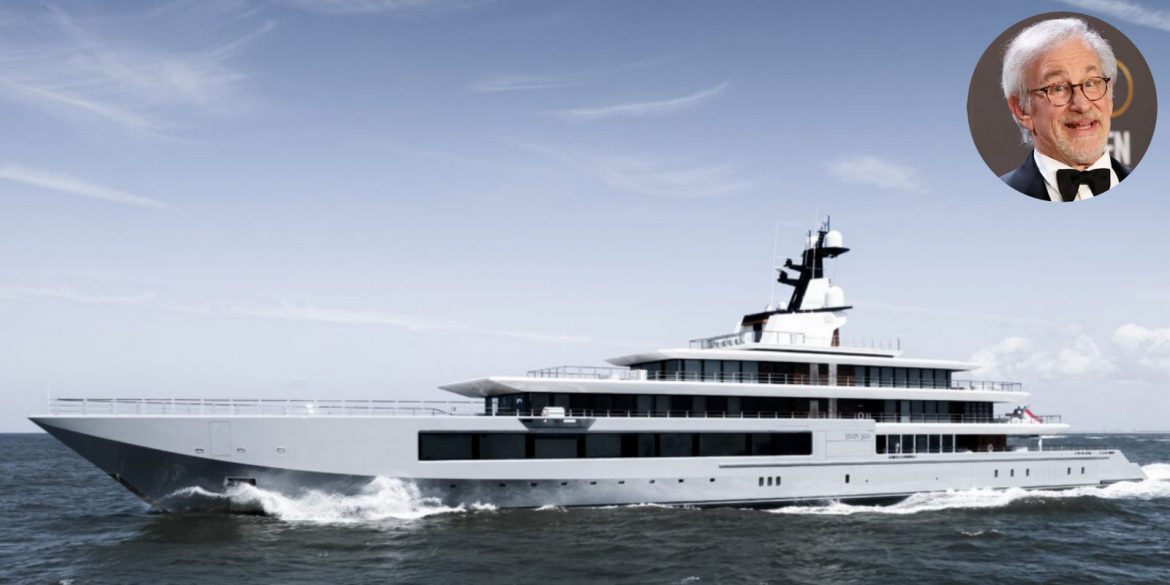
You may also like
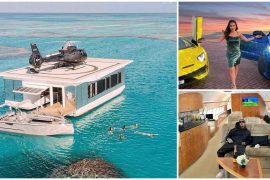
From parties in private jets to unwinding in superyachts and casual days spent in supercars – This Instagram account shows how ultra-rich millionaires are setting travel goals on land, sea, and skies!
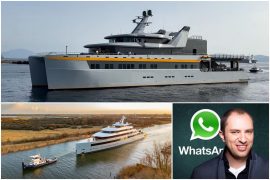

Raised in poverty, Jan Koum, the billionaire founder of WhatsApp, now has a 223 feet long vessel that exclusively supports his $220 million superyacht – It has an air-conditioned helicopter hangar, a custom catamaran, two speedboats, jet skis, and a staff of 38.
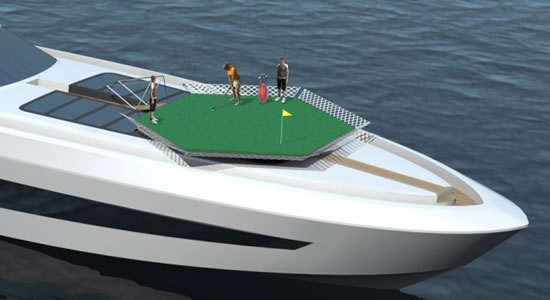
Besenzoni designs new Helybase Concept for superyachts
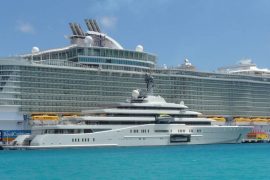
Roman Abramovich’s entire fleet of four luxury superyachts are now safe and secure in Turkey. His Halo and Garcon superyachts made a 5,000 nautical mile journey and crossed oceans from Antigua to Göcek.
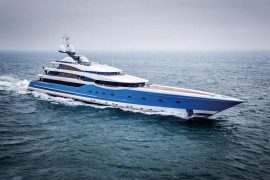
Not just his $156 million superyacht, the U.S. authorities want to seize this Russian steel billionaire’s private jet and custom helicopter. One of the first yachts to go dark, this lavish 325 feet vessel has a transforming helipad that neatly folds into a squash court.
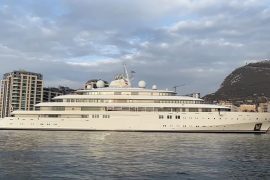
Ironically, the most expensive yacht sold in 2022 was this 404 feet long superyacht that was seized from a Saudi Prince and sold for $150 million to an anonymous billionaire
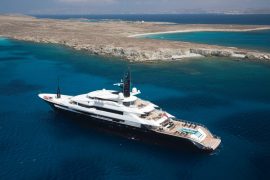
Raided and captured by the FBI, Russian oligarch’s abandoned $120 million superyacht Alfa Nero ended up disrupting the parliamentary proceedings of Antigua. Fed up from the 267ft long vessel raking up bills the Caribbean nation hastily approved its sale to collect dues.
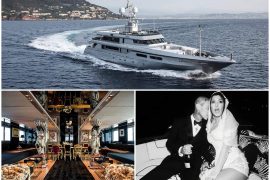
Superyacht Regina d’Italia, home to reality TV royalty, the Kardashians, during the Kourtney-Travis wedding, is an absolute queen of the high seas. The bathrooms have gold fittings studded with rubies and the furniture is dotted with leopard skin.

Not only one of the largest but this 330 feet long sailing superyacht concept will also be one of the greenest in the world – Its electric propulsion system matched with two rotating wing masts will save 225,000 liters of fuel per year.
Methodology Contact us Login
INTERVIEW: ‘I went to the school of tubing’ – Barry Zekelman
With his career origins founded in an initially loss-making family-owned structural tubing company based in ontario, canada, barry zekelman, executive chairman and ceo of zekelman industries, is now head of a multi-billion-dollar north american steel pipe and tube manufacturer..
Barry Zekelman was only 19 years old and finishing his first year of college when his father, Harry, died unexpectedly, only two years after founding a structural tubing company in Ontario, Canada, known as Atlas Tube.
With duty calling while offering him a “way out of school,” Zekelman joined his older brother Alan, who was finishing college to head up the business their father created. “In 1986 after my father died and my brother and I went to help the business, Atlas was not in great shape. But a few of the older employees helped the ‘young ones’ along, and we were able to turn around a company that had been losing about $80,000 a month. To recover, we adopted a formula of ‘buy for X and sell for Y’ that after only eight months allowed us to make our first monthly profit of $4,000. And we thought that was great.”
While those early days focused on turning the business around for good, Zekelman dedicated himself to “the mechanical aspect of the business – the machines – which came naturally to me. I fell in love right away by seeing the achievements we were able to make every day and every hour. Each day was always different and never boring, with no one day being like the last. While I concentrated on our machinery, we had some sales agents who stood by us as we focused on making the product. I guess you could say that I went to the school of tubing.”
Those humble, unprofitable days of long ago are a far cry from the Zekelman Industries, with headquarters in Chicago and 15 manufacturing locations in nine US states in the midwest, south and west along with locations in two Canadian provinces. Through both organic growth and strategic acquisitions, Zekelman, 50, today leads the company that bears his name as executive chairman and chief executive officer.
The firm has annual sales in the range of about $2.6-2.7 billion, with 2,300 employees producing and shipping 2.5 million tons of pipe and tube mill products with the brands of Atlas Tube, Picoma, Sharon Tube, Wheatland Tube, Z Modular and Western Tube & Conduit Corporation. Today the company is the largest independent manufacturer of hollow structural sections and steel pipe – and the top producer of electrical conduit and elbows, couplings and nipples – in North America. It uses nearly exclusively North American, and primarily US, steel. Long heritage Although Harry Zekelman founded Atlas Tube in 1984, today’s company traces its roots to the 1877 founding of the John Maneely Co outside of Philadelphia, Pennsylvania, a distributor of pipe, valves and fittings, which expanded into pipe manufacturing with the 1931 founding of Wheatland Tube. Other predecessors include Sharon Tube, founded in 1929, and Picoma, founded in 1970. All of those firms established their own followings and brand loyalty.
To grow Atlas, Barry Zekelman instilled in his employees the belief that their pay would rise as the company became more productive. “Some employees were asking for more money, which I didn’t have. My challenge to them was I could pay them more if we were more productive. We came up with a gain sharing program that rewards employees for eking out more tons of production and for their ideas on how to increase productivity. That release of human capital was not capital intensive, and we really haven’t changed that formula even today,” he explained.
For the next 18 years, Zekelman concentrated on expanding Atlas Tube through greenfield growth and strategic acquisitions. The firm had sales of $1.2 billion when it was approached by the private equity firm Carlyle Group, which owned John Maneely Co, to merge the two companies to increase strength in the market. According to an October 2006 article in American Metal Market, the merger created North America’s largest steel tubing manufacturer with annual sales of about $2 billion and annual volume of more than two million tons. “Although my initial reaction was to say, ‘Atlas is not for sale,’ we ended up doing the combination,” Zekelman said. The new firm, known as JMC Steel Group, “allowed us to expand tremendously while streamlining facilities and instituting incentives for continued growth,” he continued.
But the entrepreneurial itch that was passed on from the father to the son was too strong to resist after a few years. The Zekelman family had the opportunity to buy back JMC Steel Group in 2011 and in doing so has thus far retained the enterprise as a privately held business. In announcing the sale in February 2011, Andrew Marino, the Carlyle Group’s managing director, told American Metal Market: “Working closely with the Zekelmans and management, we have made JMC a stronger company economically and from an environmental and governance standpoint.” With Barry Zekelman at the helm, his brothers Alan and Clayton are partners and renamed the family-owned firm in 2016. Recent expansion Since returning to family ownership, Zekelman Industries has continued to grow. Since early 2017 it has made two significant acquisitions. First, the company completed last February the acquisition of Western Tube & Conduit Corp, giving the acquiring firm a US coast-to-coast network of mills for the first time. The addition of the Long Beach, California, mill operator expands Zekelman Industries’ share of the electrical, fence and mechanical tube market in western North America. The seller was Japan’s Nippon Steel & Sumitomo Metal Corp, plus minority shareholders. Previously Zekelman Industries did not have a non-energy-related tube mill west of Blytheville, Arkansas.
The second recent addition to Zekelman Industries followed shortly thereafter, as the firm bought American Tube, Birmingham, Alabama, to further expand its share of the hollow structural sections market, the foundation of the Zekelman brand. The Birmingham mill, founded in 1994, includes a high-speed mill and packaging line installed in 2015, and gives Zekelman Industries a foothold in the American deep south. While Zekelman Industries was solidifying its preeminent position in the North American pipe and tube market, so was Nucor Corp, the largest US steel producer. In late 2016, in rapid-fire succession Nucor acquired three different companies to also establish itself as a formidable force in the pipe and tube market. It acquired Independence Tube for $435 million for four mills in Illinois and Alabama that produce hollow structural sections. Southland Tube was bought for $135 million to also produce hollow structural sections in Birmingham, Alabama. Then Nucor wrapped up the year by announcing the purchase of Republic Conduit for $335 million; that firm, with operations in Kentucky and Georgia, makes electrical metallic tubing, intermediate metal conduit and hot-dip galvanized electrical rigid metal conduit. Is there an advantage to having a single source of steel for a pipe and tube manufacturer? Not according to Zekelman. “We buy from about 12 different mills to supply our operations. That gives me flexibility and cost savings on freight to buy on a regional basis.” Zekelman Industries’ buys of the recent past are allowing it to participate more fully in a strengthening market for pipe and tube products. Barry Zekelman said that the firm sees a very strong market for the next six to 12 months: “Our customers are telling us their business is up by double digits. The energy sector is coming alive and that could bring in about 500,000 tons a month into domestic tube mills. Plus, industrial and non-residential construction is booming, and agricultural, mining and transportation are all coming back with automation making steel easier to fabricate than alternative materials. And if a national infrastructure bill gets moving, that would supersize demand for our products.” Construction modules Modular construction is another market which Zekelman Industries is serving. The predecessor JMC Group in 2015 partnered with Amico Affiliates to launch Connexio Building Systems Inc to increase structural tubing demand in the modular construction industry. Since then, Zekelman Industries established Z Modular, which combines previously separate divisions of VectorBloc, Z Modular Fabrication and Connexio. A new factory for modular construction products opened in late 2017 in Birmingham, Alabama, to fabricate structural sections and steel sheet into three-dimensional chassis. The factory then fully finishes the chassis into rooms ready for stacking to complete a building.
Zekelman believes continued growth in modular construction will “revolutionize the construction of hotels, condos, apartments and student housing. Modular construction is somewhat of an assembly line type of scenario that is done in a controlled environment with greater quality control and worker safety. We can also better control costs and shorten the time of construction. And I believe steel will displace concrete and wood for these types of structures.”
Underpinning the company’s growth has been the steadfast resolve of Zekelman’s employees “who are energized and empowered. Our gain-sharing program rewards results, and I trust that our employees know what to do to be successful and will be rewarded for it. We listen to both our teammates and our customers.”
The company has also embraced an operating management philosophy dubbed “Make it eZ,” which uses enterprise-wide technology and employee initiative to increase efficiency and provide quick turnaround on product delivery, while offering engineering services to bring new products to market. “From website navigation to the release of trucks to in-plant process improvement, we are eliminating roadblocks across all our facilities and making a great organization even better. We are customer centric and can always improve. We believe we can build significant value by being the easiest company to do business with,” Zekelman said. Trade concerns Despite a growing market for tube and pipe products in North America, Zekelman – both the company and the man – remains concerned about the international trade environment. He has been a vocal critic of dumping of foreign steel in the North American markets and is an advocate for the Section 232 trade petition, which is an extension of the Trade Expansion Act of 1962 under which the US president can penalize imports if he decides they pose a threat to national security. At the time of writing, the Trump administration is considering a report on Section 232 from the US Department of Commerce. American Metal Market reported on February 13 that President Trump is mulling duties and tariffs against a range of nations.
“Pipe and tube has been a battleground for decades,” Zekelman said, referring to the volume of imports coming into North America and particularly the US. He characterized determining the origins of incoming products as akin to playing “whack a mole,” a popular arcade game where the mole or target is hard to hit and surprisingly will appear again on the game’s surface.
To circumvent US trade laws, a steel product can be fabricated or “made into something else in another country before it is sent here, thus making our laws very hard to enforce. The consumer ends up paying more for a product from abroad while we suffer the consequences of job losses here. It’s been ‘death by a thousand cuts’ to our industry. The enforcement of fair and appropriate trade laws will solve the woes of the steel industry by giving us consistency and the ability to invest in our jobs and our communities.”
When the married father of two children goes to Washington, DC, to support the Section 232, Zekelman naturally wears a suit and tie. But he is more comfortable in jeans and a tee shirt, and “on the shop floor rather than on Wall Street. I will do both but am more comfortable being in our plants talking to people. That is what completes me. I am an extremist of sorts, always pushing the limits to see where the breaking point is located. And although I don’t always have to win, I enjoy the challenge.”
While the Zekelman family currently controls the business, would Barry consider taking it public? “There is a time and place for everything. There are pros and cons about going public. Going public gives you access to capital to grow. It’s not about what is right for me, but rather what is right for the company. The Zekelman name is well known in the industry, and we are here to stay. And right now I am happy with the way things are,” Zekelman concluded.
By Bette Kovach
This article was first published in the March issue of the Metal Market Magazine , which carries in-depth feature articles, analyses and reviews of metal and steel markets.
- Bahasa Indonesia
- Slovenščina
- Science & Tech
- Russian Kitchen
Why are there two Altais in Russia?
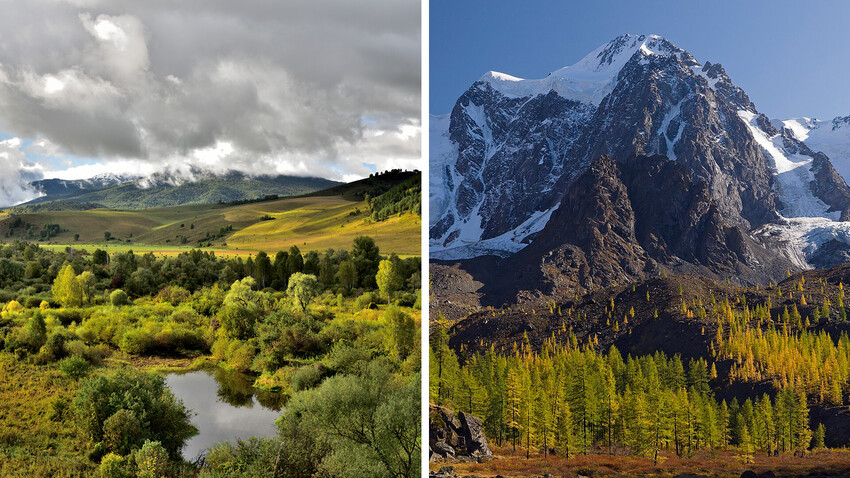
In the south of Siberia, there are two regions with almost the same name – Altai Republic and Altai Krai. This coincidence is due to the fact that the Altai Mountains are located on the territory of both subjects. But, the similarity of the regions does not end with this.
The Story of the two Altais
Since ancient times, Altai has been inhabited by local peoples and, in the 4th century AD, various nomadic tribes successively flocked there. Later, the region became part of various Turkic empires of Central Asia, including the Mongol Empire of Genghis Khan. The Turkic empires gradually disintegrated and, in the 16th century, Russia began the development of Siberia. In the 17th century, this process reached Altai.
The first Russian stockaded town in Altai appeared in 1709 and, in 1747, the Kolyvan-Voskresensky Mining District was established (in 1834, it was renamed Altai District). It included the Altai lands, parts of the Novosibirsk and Kemerovo regions, as well as several other regions. Only in 1917 Altai was identified as a separate region with its capital in the city of Barnaul. But, already in 1922, the second Altai – Oirot Autonomous Oblast – was separated from it. Oirots is now an obsolete name for the inhabitants of Altai and, later, the region was renamed the Gorno-Altaisk Autonomous Oblast. The difference between the two regions was the ethnic composition – the Oirot region was inhabited by native Altaians, while Altai Krai was mostly populated by Russians.
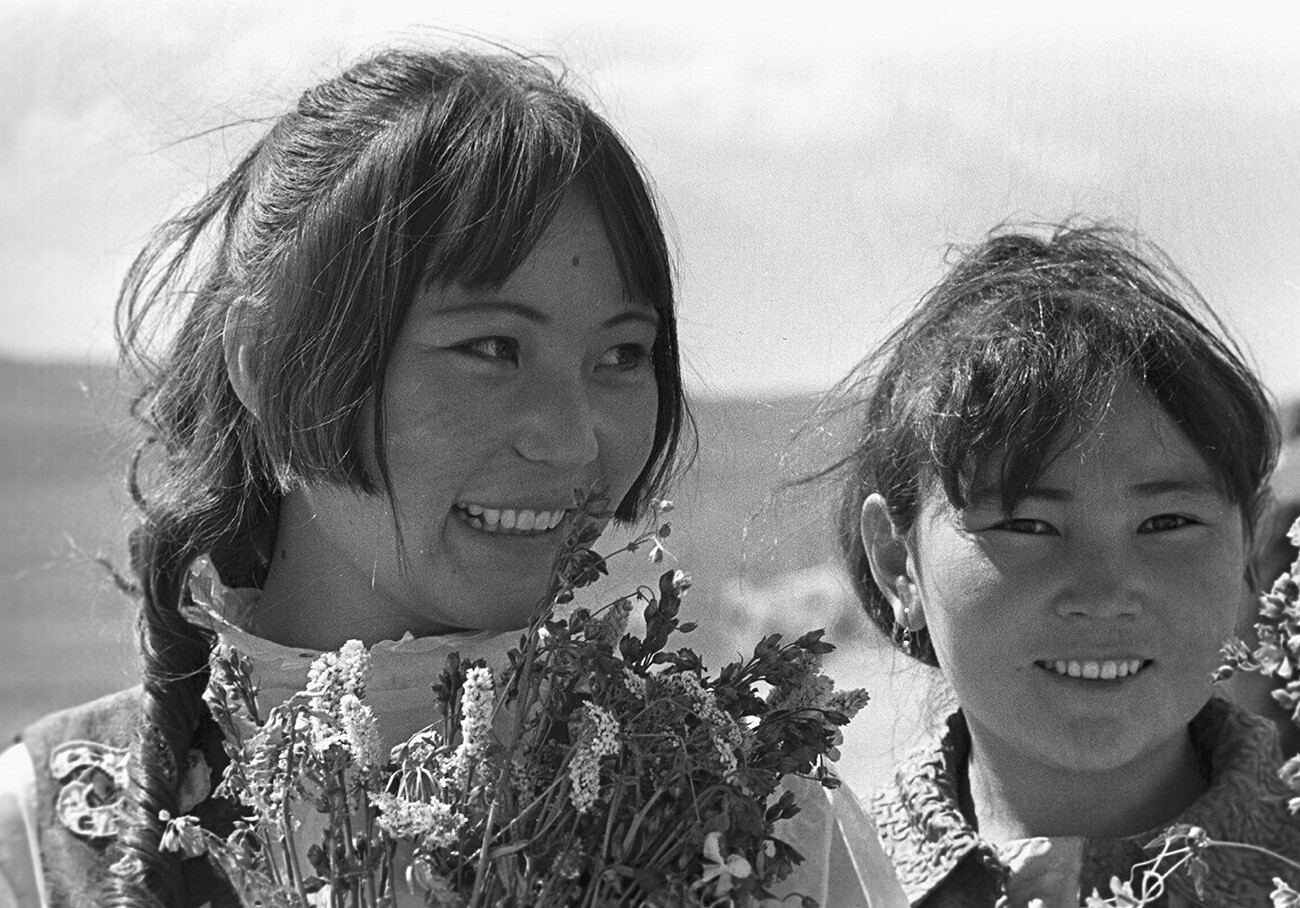
Girls of Gorny Altai.
As a result of administrative changes in 1937, the two Altai regions were united as part of Altai Krai. But, in 1991, the Gorno-Altaisk Autonomous Oblast, again, became a separate unit. In 1992, it was renamed the Republic of Altai. This is how two regions with almost the same name appeared on the map.
National composition & economy
One of the main differences between Altai Krai and Altai Republic is the ethnic composition, which remains to this day. In Altai Krai, about 93% of the population is Russian, while in Altai Republic, only 56% of the population is Russian. At the same time, 34% of the population of the republic are Altaians . This may seem like a small number, however, during the last census in 2020, only 78,125 people across Russia indicated that they were Altaians. If one takes into account migration to large cities, it becomes clear why Altaians make up less than half of the republic's population.
Native Altaians speak the Altai language, which has many dialects. In 2020, it was spoken by approximately 62,572 people. Most of the population lives in rural areas and is engaged in agriculture: they breed red deer, sheep, horses and other animals. The second important source of income for the region is tourism.
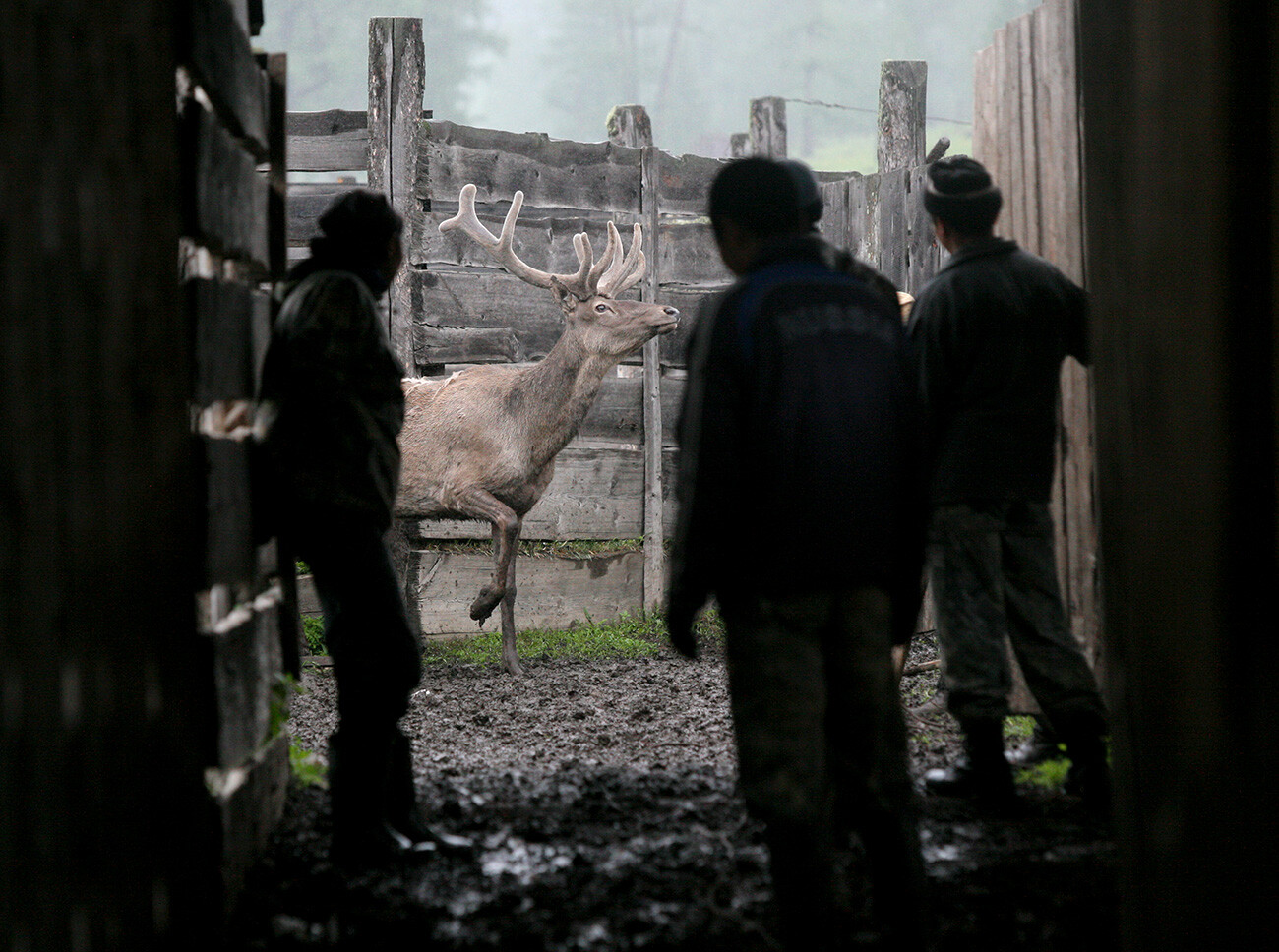
Deer breeders drive a deer into a pen for cutting antlers at the farm of the Abayskiy agricultural production company near the village of Sugash in the Ust-Koksinsky district of the Altai Republic.
Agriculture is also developed in Altai Krai, but the region's economy is dominated by the manufacturing industry. It includes the production of food, machine-building products, as well as chemical and pharmaceutical production.
Nature and recreation
If you want to see unique wild nature, where endangered animals live, you should go to Altai Republic . The ‘Golden Mountains of Altai’ UNESCO World Natural Heritage site is located on its territory. It unites Katunsky Reserve, Altai Reserve and the high-mountainous Ukok Plateau.
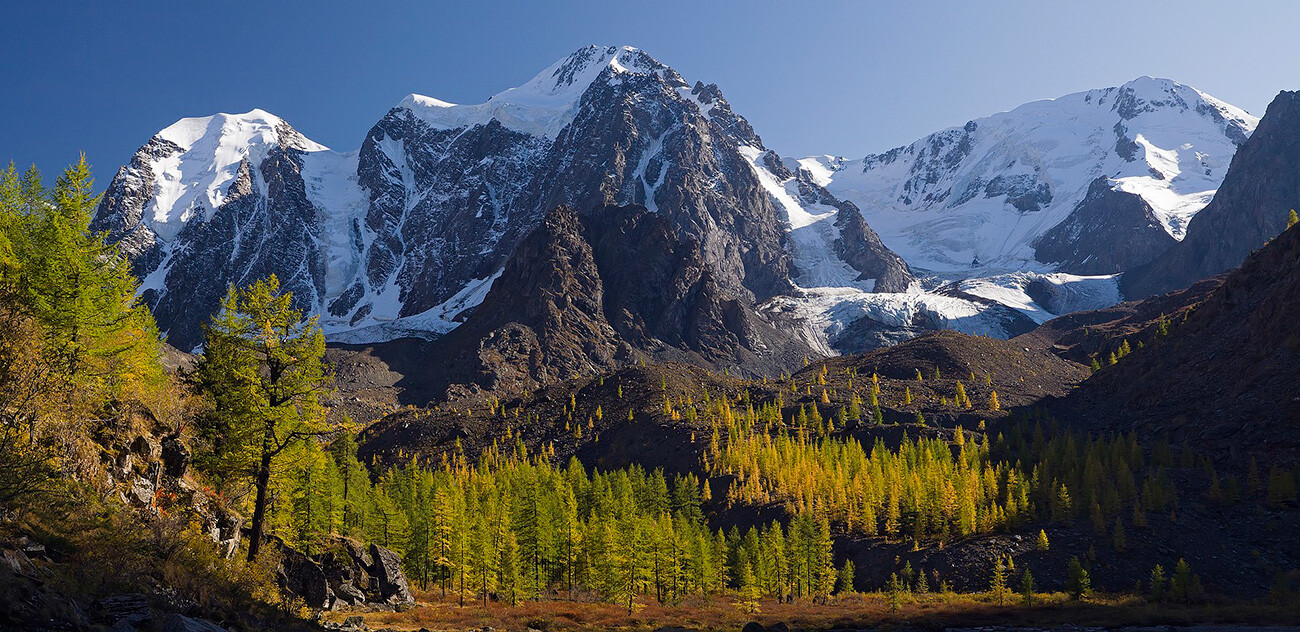
Upper Shavlinskoye Lake and the peaks of the North Chuysky ridge.
In the reserves, you can find highlands with glaciers, unique lakes, mountain rivers, waterfalls, snow leopards and manuls (Pallas’s cats). The Ukok Plateau is famous for cave paintings and ancient burials – it was there that the mummy of a girl who lived in the 5th century BC, the “Altai Princess”, was found in 1993 .
People head to Altai Republic for active vacations: trekking, mountain climbing, horseback riding tours and rafting. In this region, one will feel the regional flavor and can see some of the ancient traditions of the locals – something you will not find in Altai Krai!
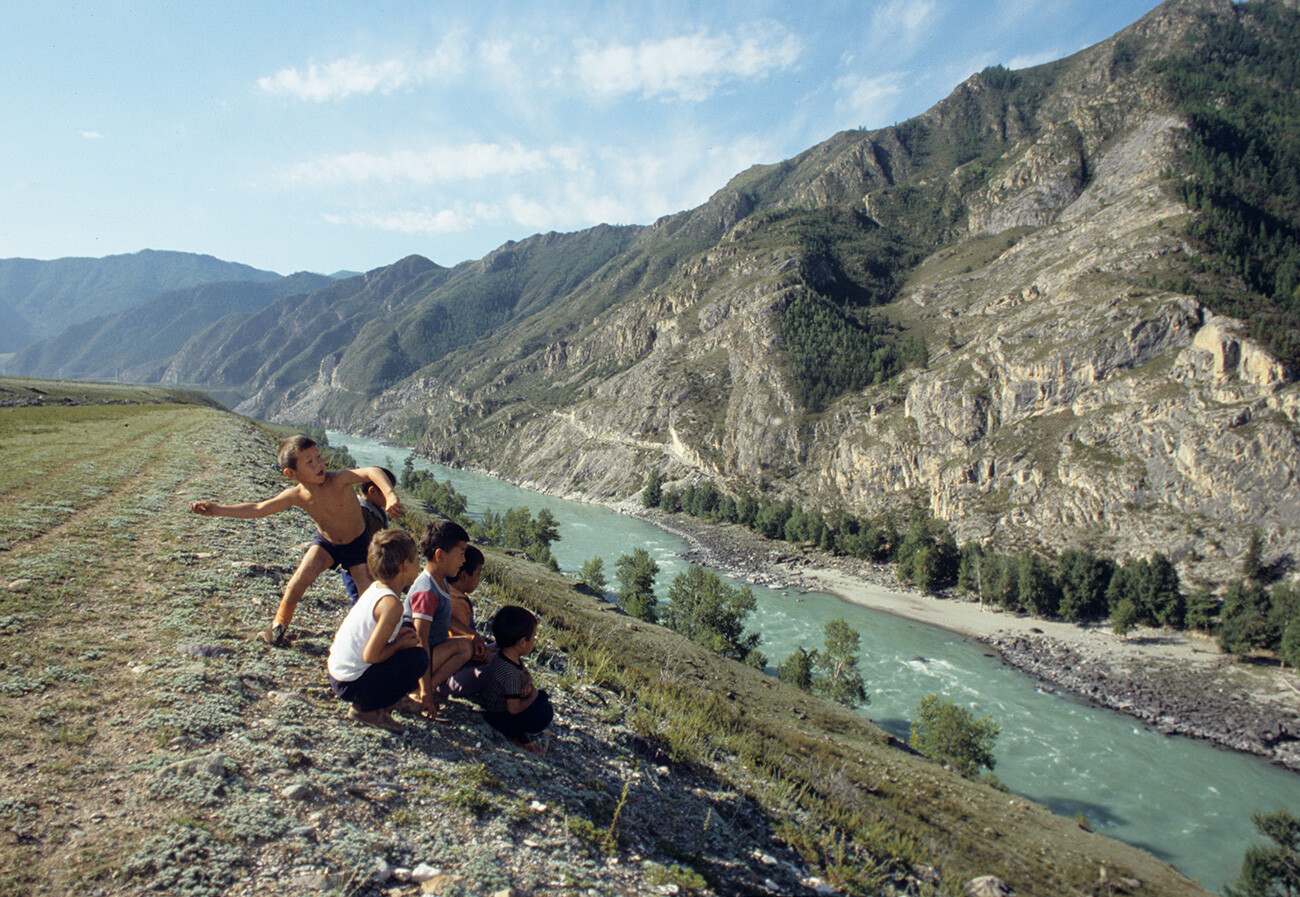
Children from the village of Inya on the banks of the Katun River. Altai Territory.
Altai Krai also has mountains, but they are smaller and lower. People go to Altai Krai for quiet vacations in spas (the most famous of them is ‘Belokurikha’) and comfortable tourist hotspots. ‘Siberian Coin’, one of the four official gambling zones authorized by the government, is also located there.
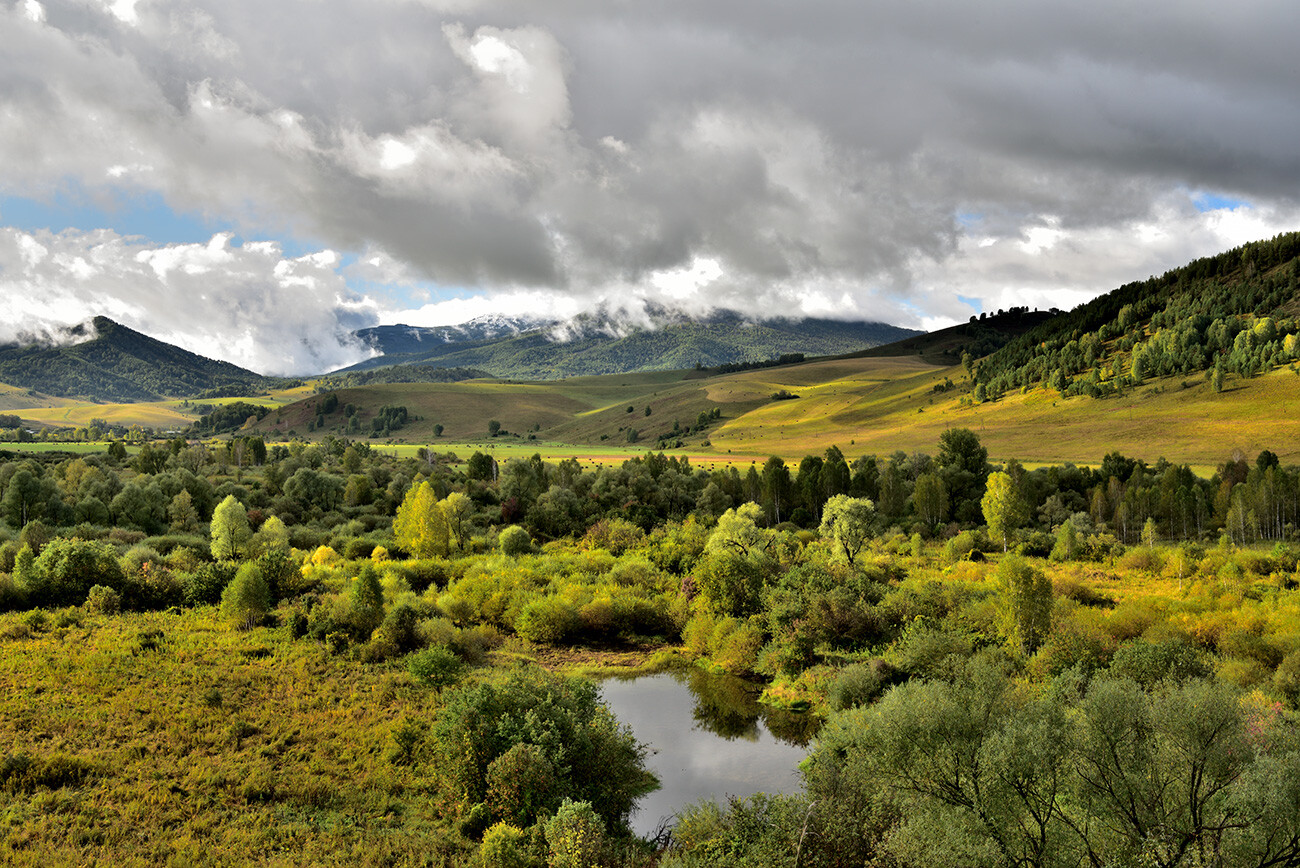
The Belokurikha resort is located on the northern outskirts of the Altai Mountains, 270 km south of Barnaul, Belokurikha, Altai Territory.
Dear readers,
Our website and social media accounts are under threat of being restricted or banned, due to the current circumstances. So, to keep up with our latest content, simply do the following:
- Subscribe to our Telegram channel
- Subscribe to our weekly email newsletter
- Enable push notifications on our website
- Install a VPN service on your computer and/or phone to have access to our website, even if it is blocked in your country
If using any of Russia Beyond's content, partly or in full, always provide an active hyperlink to the original material.
to our newsletter!
Get the week's best stories straight to your inbox
- 10 must-do things in Altai Territory
This website uses cookies. Click here to find out more.
- Weather Guides For Every Country In The World
- Algeria: Two Week Journey
- Cairo Travel Guide
- Best Time to Visit Lesotho
- Burkina Faso
- Central African Republic
- Côte d’Ivoire (Ivory Coast)
- Democratic Republic of the Congo
- Equatorial Guinea
- Guinea-Bissau
- Best Time to Visit
- Entry Rules and Visa requirements
- Salt Cathedral of Zipaquirá
- Dominican Republic
- Antigua and Barbuda
- El Salvador
- Afghanistan
- Bahrain Travel Guide
- The Cook Islands
- Aktau, Kazakhstan: Travel Guide and Tips
- Roadtrip in Western Kyrgyzstan
- Journey around Issyk-Kul
- Pakistan travel guide
- Albania Road Trip Guide
- Albania’s Entry Rules
- Yerevan Travel Guide
- Faroe Islands
- Suburbs of Paris
- Batumi Travel Guide
- Tbilisi Raves
- From Mestia to Ushguli (Svaneti) Trekking Route
- Transadjarian Highway
- Peloponesse Road Trip Guide
- Milan Travel Guide
- The Ultimate Venice Guide
- Modern Milanese architecture
- Budva Travel Guide: Montenegro’s main resort
- Montenegro Road Trip Guide
- Transylvania
- Yakutsk Travel Guide
- Journeying Through History: The BAM Railway Experience
- Veliky Ustyug Travel Guide: Meet the Ded Moroz
- Belgrade’s Cultural Guide
- Belgrade Off the Beaten Path
- Road Trip Guide
- Istanbul 🇹🇷: Hand-Painted Signs from a Century Ago
- From Grodno to Brest: a roadtrip
- Bosnia and Herzegovina
- Holy See (Vatican)
- Liechtenstein
Altai Republic (Russia) Travel Guide: A Journey through Twisting Mountain Roads
- December 13, 2023
Altai: Land of Shamanic Traditions and Otherworldly Scenery, Complemented by First-Rate Tourist Amenities
Popular ski resorts and rugged nature reserves, where few human feet have trodden — all this is the Altai Republic at once. In 2020, the region was visited by 2 million tourists — twice as many as the year before. But at the same time, untouched nature has been preserved here. We tell you where the most picturesque landscapes and unique archaeological sites are located, when and where you can see the mummy of the Altai princess, and how to reach the remote lakes where the Old Believers hid from persecution.
How often do tourists encounter bears — and who is much more dangerous than these animals? How to plan a trip and what customs and traditions of the Altai people should be remembered so as not to offend anyone? Where to stay and what to bring back from the trip? And what to pay attention to when traveling on one of the most beautiful highways in the world — the Chui Tract — and beyond its borders.
In Russia, there is the Altai Krai and the Altai Republic — these are two different regions. The Krai is located to the north, and its landscapes are mostly fields and steppes. The Republic is to the south — it is mountains and taiga, sometimes also called the Mountain Altai.
Table of Contents
Gorno-Altaysk is the capital of the republic and its only city
All the main attractions of Gorno-Altaysk can be explored in a day. The city won’t astonish you with beautiful architecture, but it’s cozy: there are many pleasant parks and squares. Founded in 1830, Gorno-Altaysk grew from a small settlement of the indigenous Teleut people. However, the first humans lived here over a million years ago: the site of the city was one of the oldest settlements of primitive man in Eastern Asia — the Ulalinka Site.

All the most interesting antiquities are gathered in the National Museum . It is a must-visit to better understand not only Altaian traditions but also East Asian culture as a whole. Altai is the ancestral home of the Scythians and Turkic peoples (Altaians, Turks, Kazakhs, and many others). In 552 AD, the ancient Turks created a state — the khanate, and here the Turkic script originated, with the Altai Mountains being a part of the Great Silk Road.
In 2012, the museum underwent a major reconstruction and is now modern and accessible — equipped with ramps and an elevator. The collection includes archaeological finds from frozen burial mounds, deer stones , statues, runic inscriptions from the Turkic period, and shamanic attributes — in a couple of hours, you can visualize all the main stages of the ancient history of the Altai Mountains.

Visitors often come to the museum specifically to see the mummy of the Ukok Princess — for whom a separate hall was built. In 1993, on the Ukok Plateau in the Ak-Alakha River valley, archaeologists excavated a burial site dating back to the 5th–3rd centuries BCE. In the tomb, a Scythian woman lay in a sleeping position with six horses. The perpetual permafrost preserved her numerous tattoos and clothing: a silk blouse, a woolen skirt, felt stockings, and a fur coat. Her head was adorned with a complex hairstyle nearly a meter high — made of hair, wool, felt, fabric, leather, and carved ornaments. Scientists took the mummy to the Novosibirsk Institute of Archaeology and Ethnography. Later, it was established that the woman died at 25 from breast cancer.
Ten years later, a devastating ten-point earthquake occurred in the Kosh-Agach region, the consequences of which are still seen as fractures and cracks in the ground. Religious people took this as a sign: the Ukok Princess was angered and wanted to return home. Some believed it was enough to bring her back to Altai, while others insisted that her body should be reburied. Eventually, in 2012, the mummy was brought to the Gorno-Altaysk National Museum.
But the disputes did not end there. In 2014, a severe flood hit the Altai Mountains, destroying hundreds of homes. Two months later, a major hailstorm with hailstones the size of chicken eggs shattered windows and slate roofs, destroyed gardens, left dents in cars, and felled trees. A couple of weeks later, the Council of Elders of the Altai Republic decided to bury the princess, and their decision was approved by the head of the region. In 2015, representatives of the Turkic Spiritual Center filed a lawsuit in the city court for the return of the princess to the Ukok Plateau, but were denied. The court justified this by stating that burial would lead to the loss of a scientific and cultural object.

As a compromise, the museum management devised a schedule for displaying the Ukok Princess. You can only see her during the waxing moon, not any day as before. In traditional Altaian culture, this is the best time for public and family events, religious and ritual ceremonies, and important beginnings. The museum’s website publishes a schedule with possible visiting dates. An adult ticket costs 250 rubles (2.49 euros), a family ticket (two adults and no more than three children from seven to 16 years old) — 450 rubles (4.48 euros).
The permanent exhibition of the museum features paintings by the main Altai artist Grigory Choros-Gurkin, a student of Ivan Shishkin. In Altai, Grigory Ivanovich is loved not only for his talented epic landscapes but also for his active public work. In 1937, the artist was falsely accused and executed in the NKVD prisons. Today, a street where the museum is located is named after the painter, and the name could have been given to the airport. In 2018, the Public Chamber proposed to name 47 Russian airports after distinguished compatriots, and online voting was conducted nationwide. Most residents of the Altai Republic chose Choros-Gurkin, but followers of Nikolai Roerich from other regions also joined the voting — the traveler visited Altai in 1926 during his Asian expedition and was also included in the list. Eventually, Roerich won by a small margin, which upset the locals so much that they decided not to name the airport after anyone.

The play ‘The Ascent to Khan Altai’ by Andrey Borisov, about the life of Gurkin, is usually one of the most popular productions in the drama theater. From the theater, you can walk to the city park and the ‘Blue Altai’ cinema. There are no particular entertainments here, but it’s a nice place for a walk: the building stands near a small lake, and almost from there starts the promenade of the Maima River. Along the bank, there’s a boulevard with gazebos and a bridge leading to the foot of Komsomolka.
Opposite is Mount Tugaya, which is great for hiking. To reach the observation deck, one must climb 750 stone steps. From this point, the entire Gorno-Altaysk is visible. Next to the mountain, there’s a stadium and a spring, adorned with marble statues of fairy tale heroes — Yrystu and Alyonushka. Sometimes there’s even a queue for the water.
Just a couple of minutes’ walk from the spring is the ‘Enchi’ ethnogallery in the printing house building. On the second floor, paintings by local artists, felt, cedar, stone, and clay souvenirs, musical instruments are sold, and you can try on national clothing. On the first floor, there’s the ‘ Typografia’ restaurant (35 Kommunisticheskiy Avenue), serving Altai cuisine: meat snacks, which are various types of boiled meat with onions; ostrich fern, which tastes like mushrooms when cooked; grayling, the most common fish in the Altai Mountains. Altaians, being former nomads, predominantly prepare dishes from meat and milk. The average bill is 500 rubles (4.98 euros), and local dishes should be ordered in advance, as 90% of the menu is European cuisine. In the ‘City’ cafe-bar (26/1 Chaptynova Street), you can try burgers with maral meat — Altai deer (450 rubles (4.48 euros)) and lamb dishes (about 500 rubles (4.98 euros)). There are a few other local dishes typically eaten in Altai. Chegen is a sour milk drink similar to kefir or ayran; boorsoki are small doughnuts fried in deep oil; Altai flatbread made from dough; talkan — ground barley grains added to tea or water with salt and butter; chokchok — a dessert made of talkan and honey; kurut — dry cheese.
The Chui Tract – one of the most beautiful roads in Russia
The road to many attractions passes along the Chui Tract. Meandering rivers along the tract, mountain gorges, green valleys, and steppes will alternate with each other. All the main natural monuments seem to be strung along this road.

In the Russian Empire, a ‘tract’ was a term used for an improved dirt road or, in general, a major well-traveled route connecting important settlements. But today in Siberia and the Urals, some roads continue to be called ‘tracts,’ mainly historical ones.
The site of the modern Chui Tract was once the Mungal Tract, references to which can be found in Chinese chronicles dating back a millennium. By the mid-18th century, it was a trade route with Mongolia, consisting of a narrow pack trail winding among passes and ridges. In 1914, the road began to be widened and improved for vehicle travel.
The Chui Tract is a federal road, and its condition is noticeably better than that of regional routes. For example, the Teletskoye Tract is also very beautiful, but its surface is significantly worse. The road from Aktash to Ulagan to Balyktyul is a dirt road that occasionally turns into asphalt.

Manzherok — a bike park in summer, a ski resort in winter, and a cable car operating year-round
The village has many comfortable tourist bases, hotels, and campgrounds — and therefore, it’s always full of tourists. In summer, people come here to ascend to the observation deck on Mount Malaya Sinyukha (1020 meters) via the gondola cable car. On weekdays, an adult ticket costs 500 rubles (4.98 euros), on weekends and holidays — 600 rubles (5.97 euros), and guests staying at hotels on the resort territory receive one trip as a gift. From the top, there are views of the Katun River and Manzherok Lake — it’s warm enough, and people even swim in it in summer. The rarefied air tints the mountains in a bluish shade, which is why Sinyukha got its name.

At the top, there’s a café with a standard selection of sandwiches, pastries, drinks, and souvenirs. You can also paraglide with an instructor — 10–15 minutes in the air cost 5000 rubles (49.75 euros), including photos and videos of the flight.
Bike rental ranges from 300 to 5000 rubles (2.99 – 49.75 euros) per hour, depending on the specifications. ‘Manzherok Bike Park’ is the first professional bike park beyond the Urals with four tracks of varying difficulty. The ‘Green’ track is for beginner riders, with a length of 1850 meters, starting from the middle station of the cable car. The ‘Blue’ track has a low level of difficulty, a wide and smooth 1700-meter-long route, also starting from the middle station, featuring jumps and simple turns. The ‘Red’ track, with a medium level of difficulty, includes two routes of 700 meters each and one of 3000 meters, with steep descents and sheer sections. And the most challenging one is the ‘Black’ track.
The park also has a 4.5-kilometer walking trail, a wooden extreme park, and a dirt pump track.

On the mountain, there’s a shaman’s hut, where from time to time one can meet a shaman (usually during the waxing moon). This is specially designed for tourists and is more of an educational and entertainment format. Normally, folk healers are not very public people, they live the same life as everyone else, and in a crowd, they are indistinguishable from ordinary passersby. Locals find them through recommendations from acquaintances. Agencies often offer various tours under the name ‘Trip to a Shaman’. But whether there will be a real shaman at this meeting is unknown.
In winter, six ski runs of varying difficulty levels open on Malaya Sinyukha. There is a separate slope for beginners, and instructors are available to teach — a one-time lesson costs from 1800 rubles (17.91 euros) per hour. For children with special needs — cerebral palsy, Down syndrome, hearing and vision impairments — specially qualified instructors conduct the lessons. They teach rollerblading in summer and skiing in winter — from 1200 rubles (11.94 euros) per hour.

Chemal — an abandoned hydroelectric station, rafting, and views from Mount Camel
It is believed that Chemal is the warmest village in all of Siberia. It has a mild climate, and there are many sunny days throughout the year — averaging 20 per month in summer. The area is known for its gardens, such as the popular ‘Peony Garden’ ecopark . The park features a guest house, a restaurant with tasty pizza (average check 700–800 rubles (6.97 – 7.96 euros)), and a nursery for ornamental plants.
Patmos and Chemal Hydroelectric Station. Altai has its own Patmos. But here, it is a very small islet — a rock with sheer walls in the middle of the Katun River, accessible by a suspension bridge. It was named after a monastery built in the 19th century. During the Soviet era, the hermitage was destroyed. In 2001, a church of John the Theologian was built on its site.

From the bridge towards the hydroelectric station runs a one-and-a-half-kilometer goat trail, in places with wooden or stone steps and railings, and in others, it’s made of clay soil. It’s better to walk here in clear weather — it’s not very safe in the rain. The trail leads to the Chemal Hydroelectric Station by a challenging but short route. This is not the only way — you can bypass the forest and Mount Beshpek via Sadovaya Street. The hydroelectric station was built in the 1930s, but today it is not operational. Various extreme attractions, rafting, and souvenir shops are located on its territory.

The most interesting souvenirs are sold in Askat — a village of artisans in the Chemal district. A clearing with workshops is located at the entrance, where you can also watch the local craftsmen at work. In the village itself, there is a linen shop and the Golovan’ master’s estate. About a kilometer upstream of Askatka is the Silver Spring — the stream’s waters are rich in silver.
Camel. A mountain with a height of 927 meters on the southeastern outskirts of Chemal, near the hydroelectric station. A well-trodden trail leads to the top, which is clearly visible even from afar. No special preparation is needed to get there, and the views of the surroundings are magnificent.

Rafting. The Katun River in the Chemal and Manzherok areas is suitable for beginner rafting. Many popular and uncomplicated routes start on the shore near Patmos or the Turquoise Katun. A three-hour rafting trip with all equipment will cost about 800 rubles (7.96 euros). Rafting on the Chemal River is a bit more challenging and costs around 1500 rubles (14.93 euros).
Karakol Lakes. From the village of Elekmonar (eight kilometers from Chemal), you can go trekking to the Karakol Lakes. Suitable for those who don’t travel further along the Chui Tract but want to see mountain landscapes. The main advantage is accessibility — almost to the lakes, ZIL trucks go, and the last part of the route can be walked or reached by a more passable GAZ-66 vehicle or on horseback. Commercial tours usually take a whole day. If you want to stay in a tent or spend a day or two at a recreational base, you can organize the trip independently, paying separately for transportation to and from each side, or walk the entire way.

In the Karakol Valley, there are many sacred places for the Altai people: the Bashadar burial grounds with sacrificial layouts, the Nizhnee Sooru site, where, according to legends, evil spirits dwell. On the left bank of the Karakol River, on the Bichiktu-Bom mountain, you can see petroglyphs from different eras. Another sacred place is Lake Arygem with its pure spring water and the Arzhun-Suu mineral spring.
On the way to Aktash — passes, ancient petroglyphs, and high-altitude lakes
Aktash is a village from which it is convenient to reach attractions towards Ulagan and Kosh-Agach. Along the way, there are many picturesque landscapes: you will have to overcome two passes — Seminsky and Chike-Taman and you can see the confluence of the Chuya and Katun rivers.
Seminsky Pass (1717 meters). Located at the 583rd kilometer of the Chui Tract. The ascent from the northern side stretches for nine kilometers, the descent to the southern side — 11 kilometers. Over this short distance, several vegetation zones will change: steppe-forest, forest, and high-mountain. There is an observation deck at the top where you can eat and buy souvenirs.

Tavdinsky Caves. A complex of 30 caves represents a kind of prototype of a multi-apartment building. People lived in these caves for several centuries: during excavations, artifacts from the early Iron and Bronze Ages were found.
The Barangol Necropolis consists of kurgans of the Pazyryk culture, which are scattered on both sides of the Chui Tract. Between the villages of Barangol and Ust-Sema, there is a six-meter Kamyshlinsky Waterfall with two drops.
Chike-Taman Pass (1460 meters). The road to the pass winds up endless twists of serpentine, and at the top, there is an observation deck with a view of these steep turns. On the platform, there are also several cafes and souvenir kiosks.

After the Chike-Taman Pass, there are many natural monuments: rock images, caves, kurgans. After the village of Inya, perhaps the most interesting of them is the Kalbak-Tash site . It is the largest complex of petroglyphs in Altai and practically on the side of the Chui Tract — it doesn’t require a long and tiring walk to reach. The oldest images are about eight thousand years old. Scientists have deciphered only about three thousand of them, and that’s far from all. If you look on your own, most of the drawings can simply be misunderstood. Therefore, it is best to go on a guided tour.

Yalomanskaya Fortress (settlement) — an ancient structure at the mouth of the Bolshoy Yaloman River. A little further — Ayr Tash Stone Gates — a place where the Chui Tract is squeezed between two sheer cliffs. Ininsky Bridge — the first and only two-chain suspension bridge built in the Soviet Union.

Chuy-Oozy — the confluence of the Chuya and Katun rivers, a sacred place for the Altai people. It is a cliff from which one can see how one river flows into another: the waters of the Chuya are muddy, those of the Katun — clear. Nearby is the eponymous nature park — a large ancient sanctuary with a huge number of rock drawings and kurgans. For example, the deer stone Adyr-Kaya, presumably erected two to three thousand years ago. It is a plate of greenish slate with a cut top. It was from this stone that the study of the deer stones of the Altai Mountains began.

Shirlak Waterfall (Maiden’s Tears). Another attraction that is easy to reach. It is clearly visible even from the road when traveling along the Chui Tract towards Chibit and Aktash.
Chibit Village. From here start the routes to the Shavlinsky Lakes, which formed due to the melting of the North-Katun Glaciers. The Lower Shavlinsky Lake is the most accessible for unprepared tourists, to which one can get from Chibit on horseback. The road is quite long — 35 kilometers, but there are many stops along the way. More prepared hikers can continue the route to other Shavlinsky Lakes and passes of the North-Chuya Ridge. Through the passes, you can reach the Maashey Glacier, go to the Karakabak Lakes or the Abyl-Oyuk and Kamry Lakes, and reach the watershed of the Kurundu and Yungur rivers. All these are challenging routes for experienced hikers.
In addition, Chibit often hosts various water racing competitions: here flows a very difficult section of the Chuya. Nearby are two waterfalls: Big Ular and Upper Karasu (Little Ular).

Aktash — an excellent base for exploring the surroundings
In Aktash, tourists are offered jeep tours around the area. A trip in an off-road vehicle along selected routes will cost about 2500 rubles (24.88 euros) per person. However, some attractions can also be reached with your own car.
Relay Station. An operating radio tower on Mount Verkhnya. From a height of 3000 meters, fantastic views of the North-Chuya Range and the Kurai Steppe open up. It’s better to go there in clear weather, otherwise, you won’t be able to see all this beauty due to the clouds.

‘Mars-1’ and ‘Mars-2’. A place that gained fame a couple of years ago when a blogger traveling in Altai dubbed these mountains ‘Martian’ on their Instagram. They are located approximately nine kilometers southwest of the village of Chagan-Uzun, and their red color comes from compounds of iron and manganese. You can drive to ‘Mars-1’, but ‘Mars-2’ requires a walk.
According to locals, they knew about the red mountains before — but didn’t consider them anything special. It’s also preferable to visit the ‘Mars’ in clear weather — the mountains acquire a Martian color only when the sun is shining. On a cloudy day, it all looks less picturesque.

The Geyser Lake is located six kilometers from Aktash. A wooden bridge leads to the lake, and on the way, you have to pass through the territory of a tourist base and pay 100 rubles. Of course, there are no geysers at the bottom of the lake, but springs. There are also three layers of clay: blue-black-blue, and the springs constantly create new patterns on the surface from these layers.
Red Gates. Rocks between which a narrow road winds, if you go towards Ulagan. The composition of these rocks includes cinnabar — a mercury mineral.
Uchar Waterfall. The largest waterfall in the Altai Republic, located within the Altai Nature Reserve.

Ulagan. A major district center with supermarkets. This is where civilization ends. Attractions along the way include the Stone Mushrooms in the Akkurum area, the Katu-Yaryk pass, and the Chulyshman river valley — also very popular places.
Kosh-Agach District — trekking to the glacier, lakes, and megaliths
Kosh-Agach is the coldest point in the Altai Republic during winter. The village is situated in an intermountain basin, hence it has a sharply continental climate. At the same time, according to meteorologists, the Kosh-Agach region is one of the sunniest in Russia. Since 2014, the country’s largest solar power station has been operating here.
Akturu Valley. To get to the ‘Akturu’ alpine camp, first, from the village of Kurai, one must reach Perevalka — an intermediate camp. From there, you need to travel either by a special vehicle or on foot. In ‘Akturu’, you can stay in a cabin, cottage, or tent. The area has baths, a cafe, and showers. The camp’s programs with excursions, accommodation, transportation from and back to Kurai cost 24,000–32,000 rubles (238.81 – 318.42 euros) per person for five days.

The easiest route to the Waterfall Stream and the Small Aktru Glacier takes two to three hours. It does not require any special preparation and is suitable for families with children. A guided tour for a group of five people costs 3000 rubles (29.85 euros). The Big Aktru Glacier (eight kilometers long) and Blue Lake are located 12 kilometers from the camp.
On a separate day, you can ascend to the Teacher’s Pass . The name is associated with the sports society of the same name, which opened a training camp here for teachers in the late 1930s. This pass leads from the Aktru valley to the valley between the peaks of Kyzyl-Tash and Jubilee. From the pass, one of the peaks of the North-Chuya Range , the Dome of the Three Lakes , is visible. It offers a beautiful view of Mount Belukha.

Throughout the Chuya Steppe (the upper course of the Chuya River), there is a huge number of archaeological monuments. For example, in the Elangash river valley, there is a complex of rock paintings stretching 18 kilometers in total. 20 kilometers southwest of the village of Kosh-Agach is the Altai version of Britain’s Stonehenge. An ancient megalithic complex of giant stone slabs over four meters high, arranged in a circle.
Teletskoye Lake — the second largest after Baikal
The village of Artybash is located on the shore of the second-largest freshwater lake in Russia. In Altai, Teletskoye Lake is called ‘Altyn-Köl’ — ‘Golden Lake’. Today, its surroundings are a protected nature reserve.
In summer, a ferry operates on Teletskoye Lake: from Yelangash (Artybash) to Cape Kyrsey (the southern shore of Teletskoye). You can admire the beauty of the lake and all the attractions along the way to Aktash. It also operates in the opposite direction. The ferry crossing for a passenger car costs 10,000–12,000 rubles (99.51 – 119.41 euros), motorcycle — 4,000–6,000 rubles (39.80 – 59.70 euros), pedestrian tourist 1,000–1,500 rubles (9.95 – 14.93 euros).

The most popular waterfall of Teletskoye, Korbu , can only be reached by water. It is 12.5 meters high. Near the bridge connecting Artybash and Yelangash, there are pleasure boats. For 1500 rubles (14.93 euros) per person, they offer tours to view the waterfalls, lasting a couple of hours. If desired, you can also go on the ‘Pioneer of Altai’ ship — but it takes five and a half hours and is more expensive — 1800 rubles (17.91 euros).
Near Korbu is another waterfall, Kishte . It is considered to be the loudest waterfall, although Korbu is taller. You cannot walk near it — it is surrounded by rocks and water, but the boats approach it closely. Opposite is the 80-meter Ayu-Kechpes, and on the western shore is Chedor, near which you can also disembark and walk, as near Korbu.
In Artybash, there are small private museums, such as ‘Ethnopark on Teletskoye’ . It consists of three yurt-museums, one of which recreates the exhibition of a traditional Altai dwelling: with a hearth in the center, and division into male and female sides. The exhibits — various household items — were shared by the indigenous residents of Altai villages over two years before the opening. The museum owner, Synaru Anatpaeva, treats visitors to herbal teas and chegen — one of the most beloved and popular national drinks in the Altai Mountains, made from fermented boiled milk. During such tea sessions, she talks about the traditions and customs of the Altai people, recalls legends about the attractions. Tourists ask about things they find interesting, such as wedding rituals, shamanism, or the history of the people.

In summer, on weekends, concerts are held in the park, where you can listen to ethnic Altai music. In addition to tours, there are workshops on felting, after which visitors leave with souvenirs made by their own hands. The ticket to the ethnographic park costs 400 rubles (3.98 euros), and the museum is closed in winter.
Uimon Valley and Mount Belukha
In the 18th century, Old Believers fled to the Uimon Valley to escape persecution. Later, local legends even suggested that the free country of Belovodye was located in these areas. Indeed, they are suitable places to hide: even today, the road to the villages of Uimon is very difficult and in places dangerous. Gromotukha Pass is a boundary with steep turns and a mound instead of asphalt. After it begins the valley. Mainly, people come here to see the Multinsky Lakes and conquer the highest point of Siberia — Belukha (4506 meters).
Multinsky Lakes. This is a cascade of lakes on the northern slope of the Katun Ridge, formed by a melting glacier in the upper reaches of the Multa River. 30 kilometers from the lakes is the eponymous village. There are several ways to get here: on foot or by truck GAZ-66 (popularly known as ‘shishiga’) or UAZ through off-road — muddy tracks, serpentine, and turbulent rivers. The trip from Multa to the lakes costs 1800–2000 rubles (17.91 – 19.90 euros), from Ust-Koksa — 2000–2500 rubles (19.90 – 24.88 euros).

In Ust-Koksa , there is the largest selection of accommodations, so tourists usually stay here. It is a district center with a population of about 4000 people. The village has a small airport and a bus station. Due to good transport accessibility, it is convenient to plan different routes from here. Tourist bases typically have their own off-road vehicles for taking guests to local attractions, or they collaborate with local drivers.
Another option is to stay closer to the lakes, in Verkh-Uimon, Multa, Maralnik, or Zamulta. These are small villages with populations of 600-700 people, so there are fewer hotels and tourist bases, but many locals rent out houses (from 1500 (14.93 euros) per day). There is not much difference in price. In Ust-Koksa, accommodations are more comfortable and there is a wider choice, but in nearby villages, this is compensated by much more beautiful landscapes — for example, the Gromotukha River and the pass of the same name.
Tourists usually visit three to five of the largest lakes, but there are a total of 42. The Multa River flows through the Upper, Middle, and Lower Multinsky Lakes, and they seem to flow into each other. Transportation usually only goes as far as the Lower Lake — beyond that, vehicles cannot pass. To reach the other lakes, you must cross the river or go around on foot.
Near the Lower Lake, it’s convenient to stay with a tent, where there are a couple of dozen camping spots, several small cabins (400 rubles (3.98 euros) per person, with outdoor washbasins and a fire pit) and a bathhouse (1000 rubles (9.95 euros) per hour), and electricity is provided by generators for a couple of hours a day. In the nearby ‘Multinsky Lakes’ mountain camp, rooms with a bathroom and a warm shower cost from 1200 rubles (11.94 euros) per day, and staying in your own tent on the territory costs 100 rubles (1.00 euros) per day.

To cross to the opposite shore of the Lower Lake, tourists use a motorboat to further access the other lakes. If there are four or more people, the cost is 350 rubles (3.48 euros) per person one way; for one to three people, it’s 1000 rubles (9.95 euros) per boat. It’s also possible to walk around the lake along the shore, about two kilometers.
The shore of the Lower Lake, which serves as the start of the route, is rocky, while the opposite shore is sandy, giving the water a turquoise hue even on cloudy days. The Shumy, the threshold where one lake flows into another, can only be crossed on foot to the Middle Lake. The Upper Lake is another five kilometers away, and a little further is the Katun Biosphere Reserve. Passes must be obtained from the game wardens (150 rubles (1.49 euros)), and a passport is required. A trail through the reserve leads to Lake Kuyguk.

Belukha is 1000 meters lower than Elbrus — the highest peak in Europe, but climbing it is considered more challenging. The mountain changes significantly each year, and the weather around the summit is very variable, with rocks falling due to glacier movements and frequent avalanches. Conquering it without mountaineering experience is not possible.

Therefore, travelers mostly go trekking to the foot of Belukha, but this also requires good physical preparation. Additionally, one must be mentally prepared for rain and cold nights. The routes can vary slightly, but usually, the entire journey takes 10–14 days. Along with guides, tourists set out from the village of Tyungur and visit Lake Ak-Kem, which reflects Belukha, the Ak-Kem Glacier, the Tekelyu Waterfall, the Valley of Seven Lakes, Kucherlinskoe Lake. Some tours include rafting on the Katun. On average, including transfers, the tour costs 25,000–30,000 rubles (248.76 – 298.52 euros).
Nature Worship. The locals greatly respect and value nature and react painfully when they encounter careless or disrespectful behavior. In June, Altaians were outraged by a video in which a Moscow blogger, for some reason, shot at the Katun River, which the indigenous people have revered since ancient times. The reaction was even sharper when a Novosibirsk company launched a mattress into the Geyser Lake with a very fragile ecosystem for an advertisement shooting.
This indignation is easy to understand, and it’s not just about the fear that the pristine beauty could be destroyed. Many Altaians still worship spirits, visit shamans, and perform traditional rituals. Nature is a cult, an animated sanctuary, and a source of pride. It is also a force with which people are closely connected, as the lifestyle of village residents remotely resembles that of their ancestors: many still engage in agriculture, hunting, and livestock breeding.
Influence of Traditions. Tourists often do not know that the colorful ribbons tied to trees in Altai are not for making wishes. Here, it is part of a religious ritual. But due to unawareness, travelers tie any piece of fabric they find to the branches, sometimes even cutting up their colorful clothing. In reality, tying ribbons is an offering to the spirits, for which people specially prepare.

The ceremonial ribbons are called ‘d’yalama’ and ‘kyira’, and they come in four colors, each symbolizing different phenomena. White symbolizes Altai faith and purity; yellow represents the sun and mountain peaks; green symbolizes plants and taiga; blue represents rivers and lakes. The ritual is performed at the new moon, in the morning or during the day. Ribbons are tied on the eastern side, in pairs — because everything on Earth has a pair. Before this, the new fabric is consecrated — fumigated with juniper. One ribbon is usually placed slightly higher as a sign that good is always stronger than evil.
The Altai people still observe old traditions, which are reflected in their daily life and creativity.

Inscriptions on Rocks. Eight thousand years ago, our ancestors left petroglyphs to pass knowledge to other generations. However, writing one’s name in paint on rocks today is of dubious value. Moreover, local volunteers struggle to restore the mountains to their original state. Since 2019, participants of the ‘Clean Altai’ project have been cleaning rocks of inscriptions along the most popular tourist routes: the passes of the Chui tract and the cliffs along the Katun, on the way to Ulagan. The work is costly and labor-intensive: there are many inscriptions, and volunteers spend hours removing paint with a sandblaster from a small area. On challenging passes like Chike-Taman, volunteers require the escort of road services due to the very steep and narrow turns.
What to Bring Back Home
Tourists usually buy honey and herbal balms based on honey, herbal teas, pantogematogen (a drink made from maral antler blood), local natural cosmetics, chocolate with pine nuts, and various cedar souvenirs. Near the passes and close to the attractions, there are always many souvenir shops. However, everything is significantly more expensive in such places, and the balms are often left in the heat for a long time, contradicting storage conditions. Therefore, it’s better to check out the same items at local markets in district centers or specialized phyto-pharmacies. In Gorno-Altaisk, such a pharmacy is located at Protocnaya Street 16/1.
Traffic Jams. During the summer, many residents from neighboring cities — Biysk, Barnaul, Novosibirsk, Kemerovo, Tomsk — come to the Altai Mountains to spend the weekend. Typically, they choose tourist bases and resorts near the city: Manzherok, Ayu, Biyuzovaya Katun, Chemal — places that can be visited in a day before returning for the start of a new work week. Therefore, starting from Friday evening and throughout the weekend, there is increased traffic on the Chui tract, sometimes leading to traffic jams. Serious collapses are rare, but it’s useful to know this feature to plan travel time — for example, not to miss a flight.
Wild Animals. The most common animals you’ll encounter are harmless rodents like chipmunks or squirrels, not bears. In the forests, be cautious of snakes. The likelihood of encountering a bear during a stop is very low — the brown bear is a cautious creature and usually does not want to encounter humans. In the summer of 2021, bears were spotted several times at Teletskoye Lake — where the Katun Biosphere Reserve is located. Who is more dangerous in such encounters — human to bear or bear to human — is a debatable question. In most cases, bears are scared of humans and run away, especially if the encounter occurs in a populated area .
Tick Season starts in spring and ends in autumn. Park areas and tourist bases are treated for dangerous insects, but if you plan to hike or take long walks in nature, it’s better to get vaccinated against tick-borne encephalitis (the most serious disease transmitted by ticks) before the trip. The procedure usually consists of three stages. The first vaccine is given in the fall to prepare for the spring-summer epidemic, then another one in early winter. The third vaccination is done 9-12 months after the first. After that, the body will develop immunity for about three years.
If you don’t want to bother or if there’s little time before the trip, you can buy tick insurance. It’s sold by most insurance companies and costs about 400 rubles (3.98 euros). This amount can save money if you are bitten by a tick infected with encephalitis or Lyme disease. Without insurance, immunoglobulin injections for a person weighing 60-70 kilograms will cost at least 8000 rubles (79.60 euros).
Where to Stay
Accommodation in the Altai Mountains can be found to suit any taste and budget. If you go during the peak tourist season, it’s better to book accommodations in advance — at least a couple of months ahead. In Altai, the rule is – the closer to district centers, the greater the choice of comfortable accommodations.
Finding a place for a tent is not difficult. Tourists most often stay near the banks of the Katun River, where there are many organized camping sites. However, it’s most comfortable to camp on the territories of tourist bases: they are usually guarded and treated for ticks, and amenities include a bathhouse or shower. The price per person is on average about 150 rubles (1.49 euros) per day. But there won’t be much unity with nature or romantic campfire gatherings here.

The perfect combination of comfort and nature is glamping, but they usually only operate in summer. Glamping sites are often located in beautiful natural areas, and tourists stay in large tents, sleep on soft beds, and the site has showers with hot water and offers meals and organized excursions. Prices vary depending on the level of comfort. For example, a double yurt in “Ethno House Yurt” in the village of Aktash costs 1500 rubles (14.93 euros) per day, with shower and toilet in a separate building. In “Cheposh Park,” the minimum price for a double tent with a shower is about 5000 rubles (49.75 euros).
Here are a few more options: “Saikol” three kilometers from the village of Kurai, Cloud Park Altay in the Chemal district, the tent mini-hotel “Forest and Sea” in the Kosh-Agach district, and “Taigala” near Chibit.

How to Get There. In 2023, traveling from Europe or the UK to Gorno-Altaysk in the Altai Republic involves a series of connecting flights, as there are no direct flights to this destination.
One option is to fly to Istanbul, Turkey, utilizing airlines like Turkish Airlines, which offers extensive connections from various European cities. From Istanbul Airport (IST), you can then take a flight with Pegasus Airlines or Turkish Airlines to Russian cities like Moscow or Novosibirsk.
Another option is to fly to Yerevan, Armenia, with airlines such as Air France, Lufthansa, or British Airways offering flights to Zvartnots International Airport (EVN) in Yerevan. From Yerevan, you can take a connecting flight to Moscow with airlines like Aeroflot or Armenia Aircompany.
Direct flights to Gorno-Altaysk are available from Moscow, Kazan, Novosibirsk, and Krasnoyarsk. With the start of the summer tourist season, Nordwind Airlines offers direct flights from St. Petersburg. A round-trip ticket from Moscow to Gorno-Altaysk costs on average between 6000 to 15,000 rubles (59.70 – 149.26 euros). It’s also possible to fly to Barnaul (700 kilometers from Gorno-Altaysk), Novokuznetsk (800 km), or Novosibirsk (900 km), and then travel to Gorno-Altaysk by land transport. A ticket to Novosibirsk costs 5000–10,000 rubles (49.75 – 99.51 euros), plus an additional 3000 rubles (29.85 euros) for a bus and another seven hours on the road.
The nearest railway station to Gorno-Altaysk is located in Biysk, 100 kilometers away. To reach the capital of Altai, you’ll need to travel by bus or taxi. From Moscow to Biysk, the train journey takes two days, and a one-way ticket costs about 7000 rubles (69.65 euros). There are also trains from Novosibirsk and Barnaul.
These routes may involve overnight layovers, so it’s advisable to plan for potential stays in transit cities.
Getting Around the Republic. During the summer, Let 410 planes from “Siberian Light Aviation” with a capacity of 19 passengers fly to remote district centers from Gorno-Altaysk. There are flights to villages like Kosh-Agach and Ust-Koksa, with one-way tickets starting from 1500 rubles (14.93 euros). The journey takes about an hour. It’s a great opportunity to quickly reach your destination and experience flying in a small plane. Bus number 103 runs from the airport to the bus station in Gorno-Altaysk. A taxi ride would cost about 300 rubles (2.99 euros). Traveling to Kosh-Agach from Gorno-Altaysk by car takes no less than eight hours.
Daily scheduled buses run from Gorno-Altaysk to the most popular tourist destinations. The bus station does not have its own website, but it has an official Instagram account with a link to E-traffic , where you can view the schedule and buy tickets. Main destinations include Manzherok (about 120 rubles (1.19 euros)), Chemal (350 rubles (3.48 euros)), Onguday and Shebalino (400 rubles (3.98 euros)), Turochak and Artybash (500 rubles), Ust-Koksa and Multa (1000 rubles (9.95 euros)), Kosh-Agach and Tyungur (1500 rubles (14.93 euros)). An alternative is to find carpooling options on BlaBlaCar or rent a car. For example, on Booking Car , the minimum price for a car is 1700 rubles (16.92 euros) per day. Car rental services “Za Rulem” (Communist Avenue, 81, bldg. 2) and Arget (Biyskaya Street, 23) offer cars for an average of 2700 rubles (26.87 euros) per day.

When to Visit
In Altai, the climate is sharply continental: winter doesn’t hold back on frosts, and summer on heat. The weather greatly depends on the region, but in Gorno-Altaisk and the nearby villages, the warmest month is July. The average temperature is around plus 19 degrees Celsius, and heat up to plus 36 degrees can last for a couple of weeks. Nonetheless, even if traveling in the middle of summer, you should bring warm clothes. For example, the temperature on mountain passes is five to six degrees lower than on the plains.
Winter. In winter, people primarily come to Altai for picturesque landscapes and ski resorts. In Gorno-Altaisk, you can ski or snowboard on Komsomolka (402 meters) — an easy track suitable for beginners. The neighboring Tugaya mountain is designed for those with more serious sports training. But lovers of active recreation often choose ski resorts outside the city: ‘Manzherok,’ ‘Teletsky,’ or the ‘Semin Pass’ training center. Initially envisioned as a base for training athletes, it is now open to tourists.
Spring. At the end of April to early May in Altai, the red rhododendron blooms — this endangered shrub covers the mountains and rocks with bright pink flowers. Residents of nearby cities often come during the May holidays to see the bloom. There is especially a lot of rhododendron in the Mayminsky, Chemalsky, Ongudaysky districts, and beyond the Chike-Taman pass. Spring is also the best time to see waterfalls as they are full-flowing.
Summer and Autumn. In summer and autumn, there are more options available — from contemplating natural expanses to trekking in the mountains or off-roading in uninhabited areas. By mid-September, one of the main rivers, the Katun, becomes strikingly turquoise — the water changes color several times a year.

Related posts:
- The Vertical Grain Elevator (Silo) in Samara — A Benchmark of Brutalist Architecture
- Yekaterinburg: A Comprehensive Guide to the Ever-Young and Protest-Ridden City
- Kazan Travel Guide: Vibrant “Third Capital” of Russia
- Dagestan Road Trip Guide: A Week’s Journey Through the Caucasus Mountains
Leave a Reply Cancel reply
Your email address will not be published. Required fields are marked *
Save my name, email, and website in this browser for the next time I comment.

IMAGES
VIDEO
COMMENTS
The Man of Steel Yacht is a luxurious vessel built by esteemed Dutch yacht builder Oceanco. The yacht, valued at US$ 150 million, can accommodate 12 guests and maintains a crew of 26. It is powered by 2 MTU engines, giving it a top speed of 20 knots and a cruising speed of 14 knots, with a range of 4,750 nautical miles.
The stunning Man of Steel yacht was bought by tycoon Barry Zekelman in 2021 Billionaire Barry Zekelman, worth $3.5 billion, was born with a diamond-studded platinum spoon in his mouth. The wealthy family was known as one of North America's largest steel pipe and tube makers, a steel business that Zekelman took over at 19.
Barry Zekelman is a Canadian billionaire and co-owner of Atlas Tube, a company that grew under his leadership from 5 to 2,000 employees. After selling Atlas Tube to the Carlyle Group, the Zekelman family repurchased the company and rebranded it as Zekelman Industries in 2016. Beyond his business successes, Barry Zekelman is known for his ...
MAN OF STEEL Yacht - Premier $150 M Superyacht. Measuring 86 meters, she is one of the world's largest yachts. Previously known as SEVEN SEAS, the name was inspired by the fact Spielberg had seven children. He owned the vessel from her delivery in 2010 through to 2021.
Merle Wood of Merle Wood & Associates, the brokerage firm that orchestrated the sale, told Forbes that the yacht" was renamed Man of Steel, a name Zekelman is known to use for his boats, though ...
Formerly owned by Steven Spielberg, the stunning MAN OF STEEL yacht measures a length of 86 meters she is one of the world's largest yachts.Previously known ...
The yacht carries two custom-built tenders — a 30-foot open sport boat and 34-foot "limousine" boat. With an estimated top speed of 20 knots (37 km/h), it has a cruising range of 5,200 ...
1 / 1 Windsor, Ontario billionaire Barry Zekelman, owner of this 86-metre superyacht once owned by Steven Spielberg, has recently acquired a five per cent interest in Algoma Steel Advertisement
The Inception Yacht is a luxury vessel built by Heesen Yachts in 2008 and designed by Omega Architects. Initially named MAN OF STEEL, it was originally owned by Canadian billionaire Barry Zekelman. Powered by MTU engines, Inception can reach a max speed of 16 knots and boasts a range of over 3,000 nm. The luxury yacht can accommodate 12 guests ...
Built in 2010, the 282-foot yacht can accommodate 20 guests, has nine staterooms, a helipad and a movie theatre.
Billionaire film director Steven Spielberg has sold his superyacht SEVEN SEAS for $150 million to billionaire Steel baron BARRY ZEKELMAN. November 5, 2021.🔊...
Zekelman's net worth has been estimated at 3.46 billion, making him the 24th richest person in Canada. He and his wife own a yacht named Man of Steel. Ther 164-foot craft is a replacement for ...
Barry Zekelman took over his family's steel business at age 19 and has since grown it into one of North America's largest steel pipe and tube makers. He sold the company to the Carlyle Group in ...
MAN OF STEEL Yacht - Barry Zekelman's $150M Superyacht. Like. Comment. Share. 5K · 50 comments · 63K views. Yacht Bible
Via Youtube / @Dutch Yachting The 358-footer gets its power from twin MTU 20V 4000 M73L diesel engines that allow the vessel a top speed of 20 knots. Seven Seas is already setting records as the first LY3-compliant yacht to feature a marine evacuation system. While the luxurious amenities are still sheathed in secrecy, we can ascertain this mammoth will cost the ardent environmentalist $25-$30 ...
The Seven Seas yacht, valued at $250 million, was built in 2022 by the renowned Dutch yacht builder, Oceanco. It is powered by top-of-the-line MTU engines and can reach a maximum speed of 20 knots. The vessel, designed by SINOT Yacht Design, can accommodate 14 guests in 7 suites with a dedicated crew of 30. Steven Spielberg is the proud owner ...
March 7, 2018. By Generic people page. Barry Zekelman was only 19 years old and finishing his first year of college when his father, Harry, died unexpectedly, only two years after founding a structural tubing company in Ontario, Canada, known as Atlas Tube. With duty calling while offering him a "way out of school," Zekelman joined his ...
The Altai Mountains, considered by some the "Green Pharmacy" of the earth and the "lungs" of the planet, is one of the cleanest and most unpolluted regions in Russia. As a result of its ...
In Altai Krai, about 93% of the population is Russian, while in Altai Republic, only 56% of the population is Russian. At the same time, 34% of the population of the republic are Altaians. This ...
Altai: Land of Shamanic Traditions and Otherworldly Scenery, Complemented by First-Rate Tourist Amenities Popular ski resorts and rugged nature reserves, where few human feet have trodden — all this is the Altai Republic at once. In 2020, the region was visited by 2 million tourists — twice as many as the year before. But at… Read More »Altai Republic (Russia) Travel Guide: A Journey ...
Barnaul (Russian: Барнау́л, IPA: [bərnɐˈul]) is the largest city and administrative centre of Altai Krai, Russia, located at the confluence of the Barnaulka and Ob Rivers in the West Siberian Plain.As of the 2021 census, its population was 630,877, [14] making it the 20th-largest city in Russia and the fourth-largest in the Siberian Federal District.
An in-depth profile of Barry Zekelman, the Canadian billionaire and co-owner of Atlas Tube, renowned for his business ventures, philanthropy, and enviable net worth. ... BARRY ZEKELMAN • Net Worth $3 Billion • House • Yacht • ਪ੍ਰਾਈਵੇਟ ...
What began as a pastime for yacht spotting has evolved into a leading online destination for yachting enthusiasts, with thousands of visitors engaging with our content every day. Launched in 2009, SuperYacht Fan transitioned from a gallery of yacht imagery to a pivotal resource, culminating in the Super Yacht Owners Register —a meticulously ...